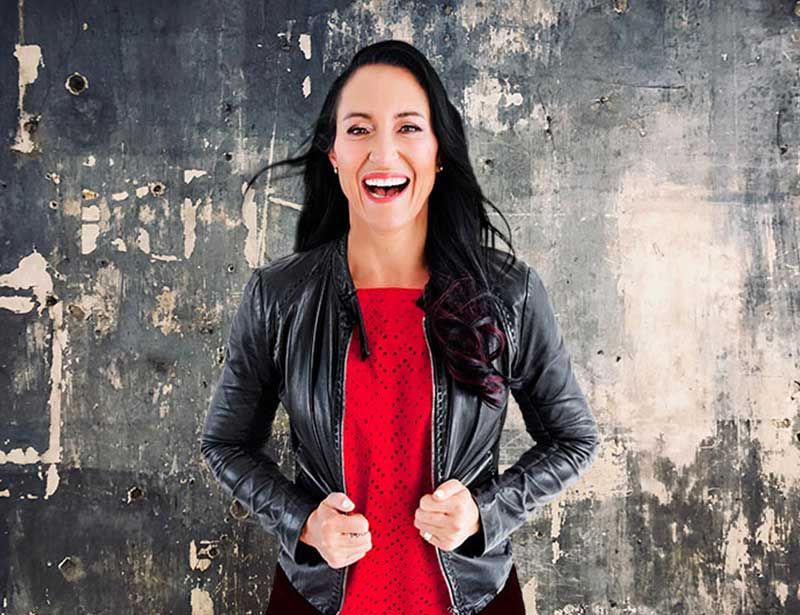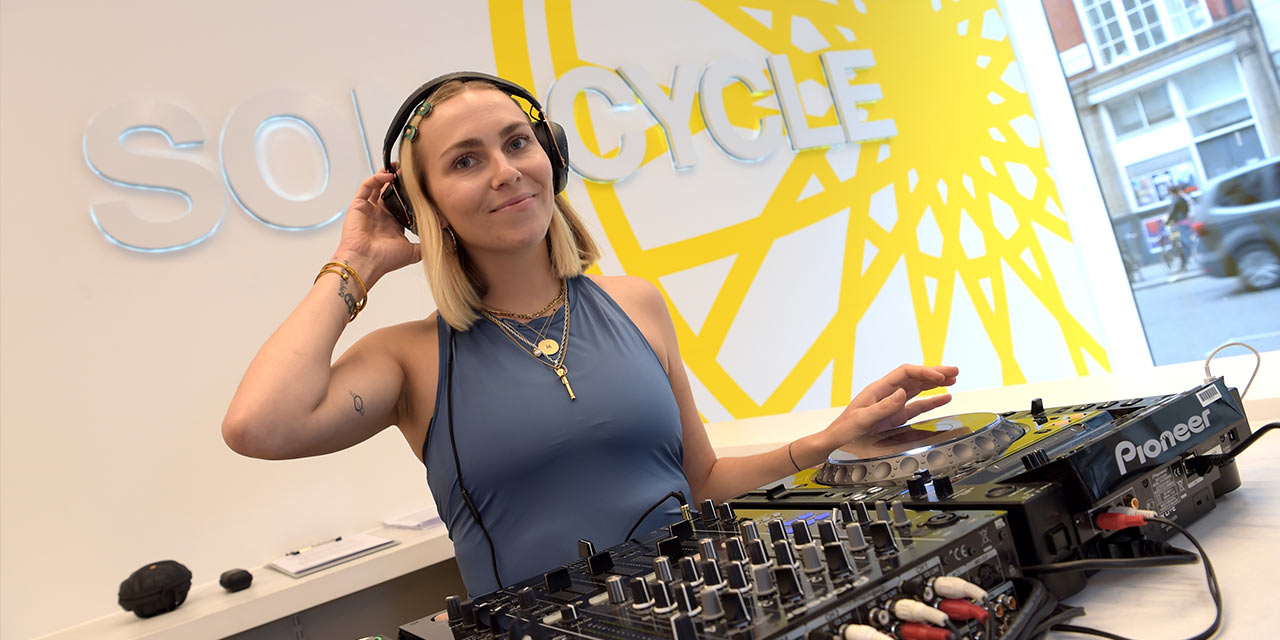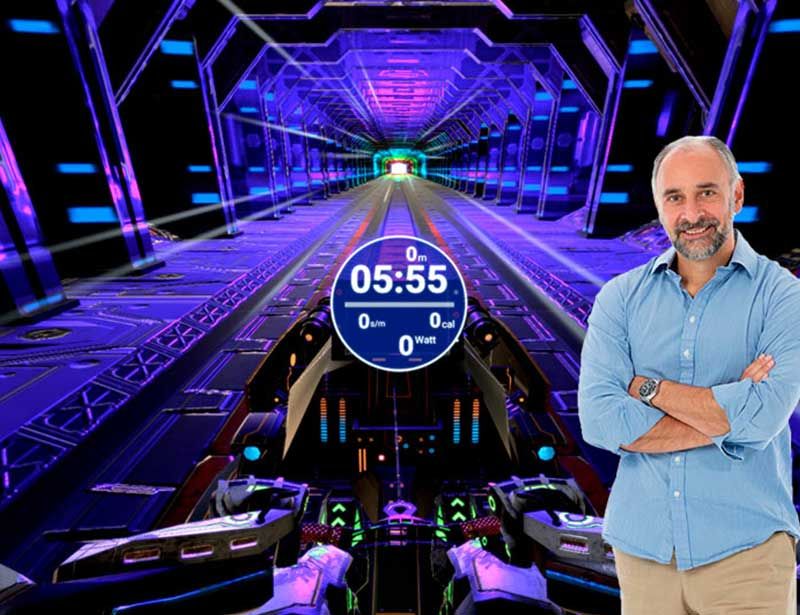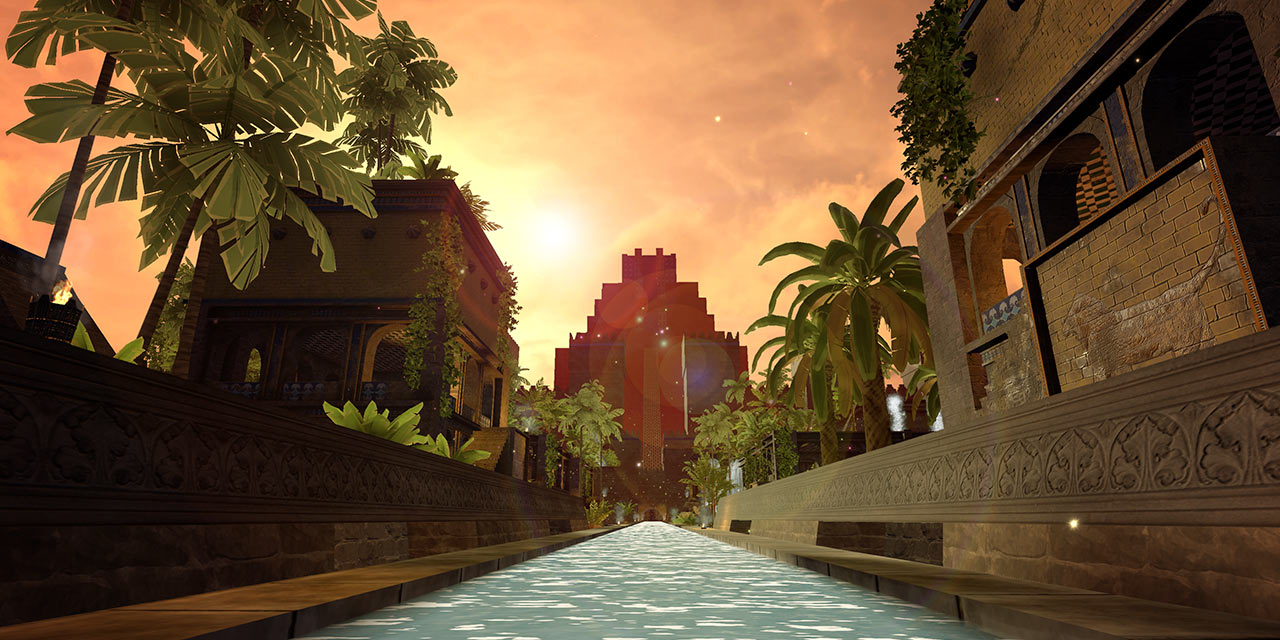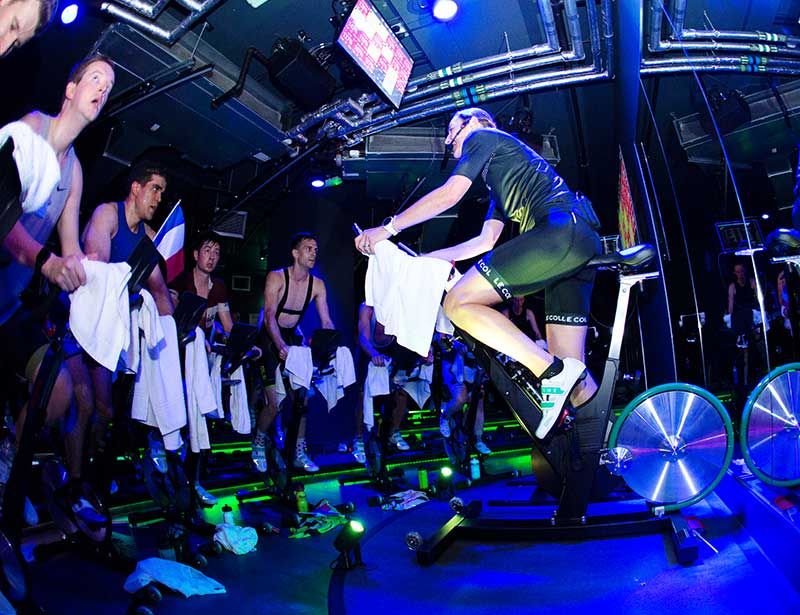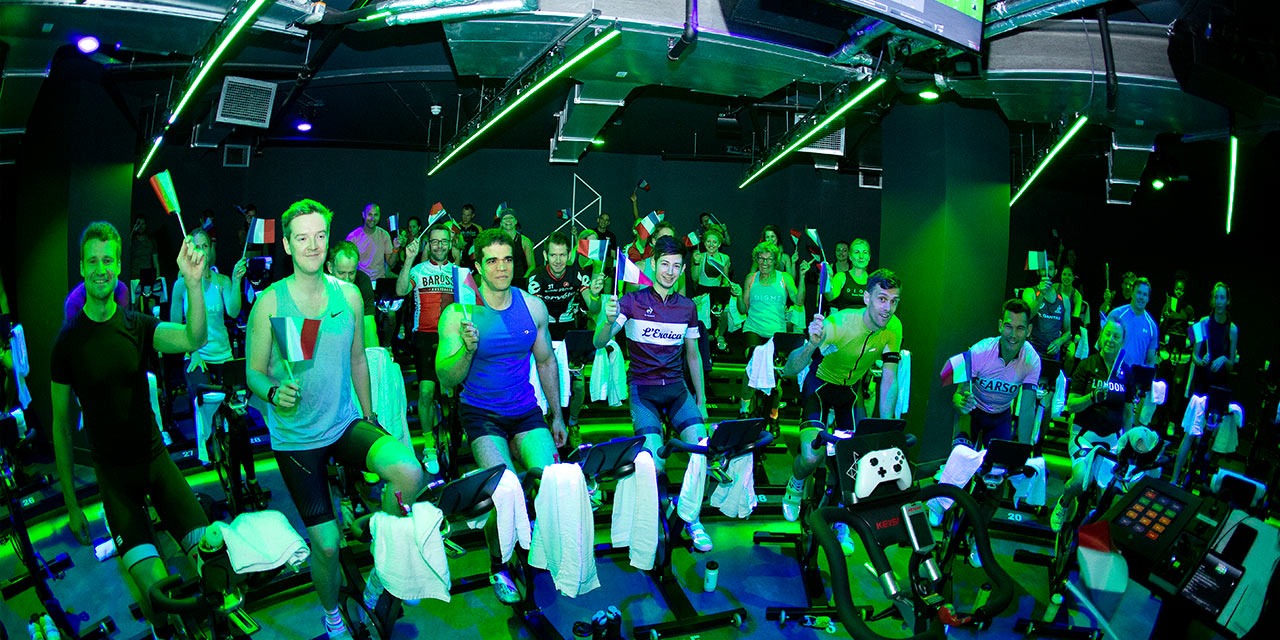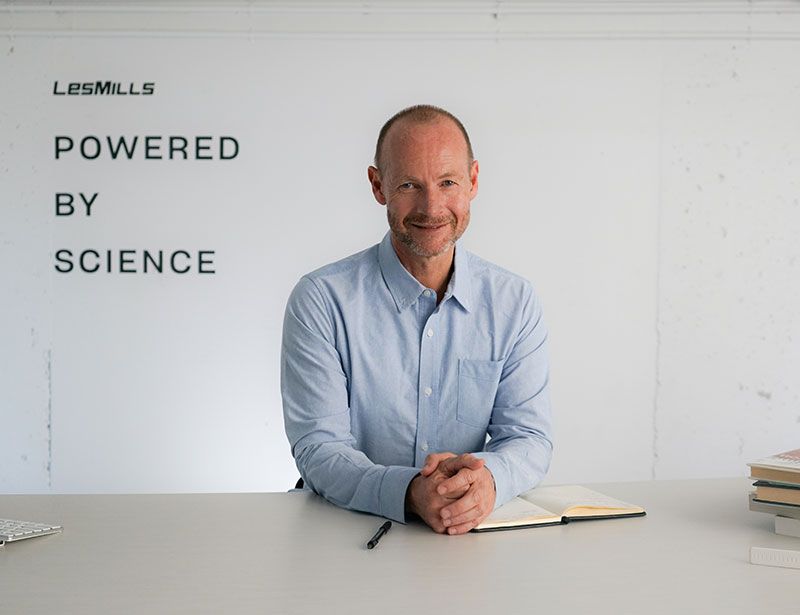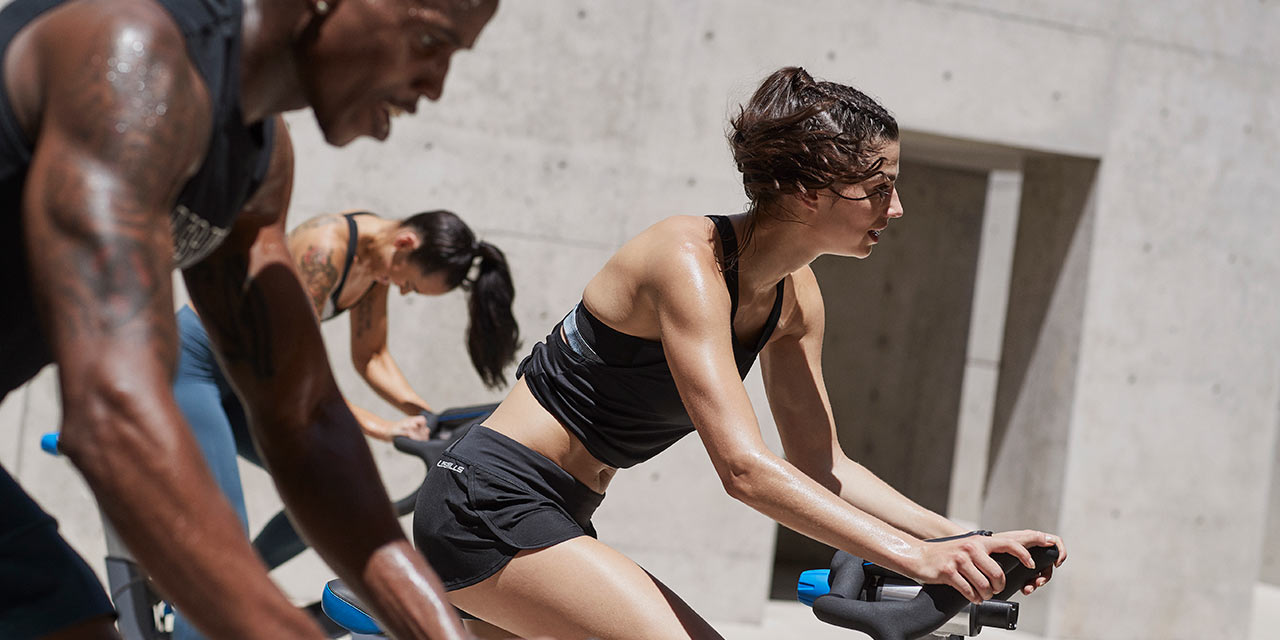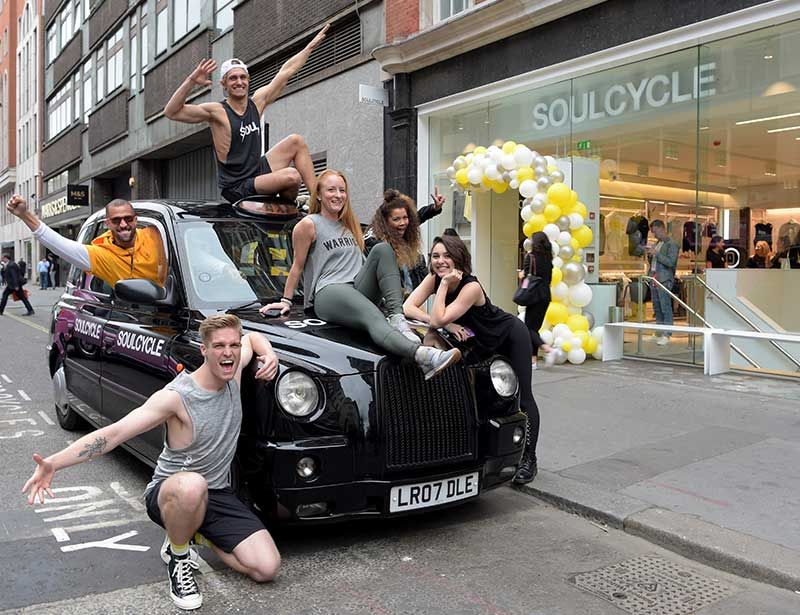Author: Pernille
Cycling Takeaways
#1 It’s not about cycling
The best way to think about the future of at-home cycling is to forget about cycling altogether. Think of it as just another service you’re passionate about receiving. Think food. Think fashion. Think human behaviour.
Amazon has primed us to expect immediate delivery by drone or robot, Netflix is feeding us intoxicating content based on our preferences, Fortnite has us adventuring off-world with friends. These examples tap the tenets of convenience, hyper-personalisation and community and are showing fitness the way – which brings us to Peloton.
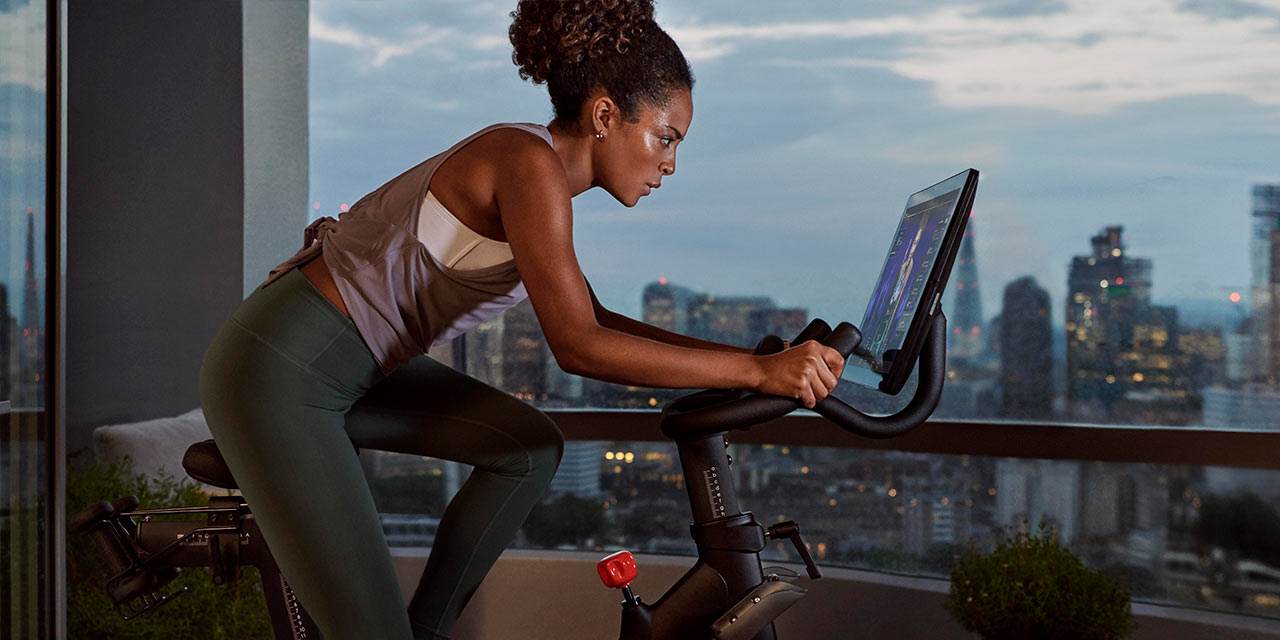
#2 You don’t have to be first but you do have to be best – and loudest
Reported to have more customers than SoulCycle and better retention than Equinox, Peloton was not the first to deliver at-home workouts by a long shot, riding the slipstream of greats before them – from Jane Fonda to Beachbody’s P90X to Kayla Itsines getting more bodies into bikinis than anyone before.
However, what Peloton has done is wheel a boutique fitness experience into the home with a software-hardware-subscription solution that happily touts a 2-foot commute – and which it then advertised, everywhere.
#3 It’s about the bike
Cycling is a business basic for the body.It meets our bipedal design in the seat, offers low impact but weight-bearing exercise, easily adjusts for pace and resistance, has you sweating within minutes by dialling to the right, and requires next to no co-ordination.
Boom. A slam dunk for fitness and the reason it has dominated gyms, studios – and our own basements – since 1965.
#4 … But also not
Purists now measure up to Zwift, rhythm-riders follow the beat and SoulCycle gets predictably spiritual by using the bike as the vessel to channel riders to find their soul.
More and more, the indoor bike is less a piece of fitness equipment and more the means to access a range of increasingly personalised workout experiences, both in the club and at home. The result? Those experiences can command a premium – which brings us to point #5.
#5 Giving exercise value
In the same way SoulCycle placed a higher value on group fitness by raising the price tag per ride, Peloton raised the stakes at home by elegantly connecting experience and community and making it sticky enough to produce startling engagement – an average of 13 rides per month.
Both brands upped the experience in ways customers cared about. Soul offered a personal and communal high never experienced before, and then shouted to the world through its evangelists and stellar PR. Peloton connected riders to live-streamed NYC rockstars, and each other, and then spent massive marketing dollars obtaining brand omnipresence.
#6 The big four
As with boutique fitness studios, there will be a proliferation of business models, price points, delivery mechanisms, programming ideas and bundled services in the at-home cycling market.
GAFA – Google, Amazon, Facebook, Apple – and others are stepping onto our playing field. They are certainly rubbing their hands together in glee as they prepare to stretch out their long arm of end-to-end product, service and delivery to target unmet fitness consumer needs.
The race is on to own the whole end-to-end supply chain of fitness, and the winner is likely to be he with the biggest database, she with the biggest following, they with the deepest data and pockets. Of the US$4.2trn global health and wellness market, we are a small bubble and ripe to be picked.
#7 Sparking innovation
Pricing will always play a part in market growth and at-home cycling is no different. As one of the key levers, wherever there is a pricing delta, a new business model or player will emerge. Cue Echelon Connect.
#8 Clues to the future lie with the trendsetters
Those who say it’s impossible to predict the future would do well to watch the trendsetters, including those who have already shaped the present.
SoulCycle’s 20-person digital content team – tapping senior talent from Mashable, Glamour and Vox Media, along with the joint-venture launch of a talent agency with Equinox – shows it is keeping people at the centre of its brand while at the same time as doubling down on its digital expression.
Sound by Soul is one such expression, delivering transformative content through music video, audio and transformative events to complement the brand’s studio-based experiences.
The brand’s mission: to delight in new and unique ways.
#9 Done well, tech is crack for engagement
With the accelerating force of AI, and the ongoing development of VR and AR, fitness will soon be as engaging as PlayStation for a 12-year-old boy. The coaching capacity and ability to enhance the experience will be a dimensional shift in exercising. Tech will help take us to dizzying depths of new sensation.
Our biometrics will directly inform our optimal programming and nutrition plan, while personalised nudges throughout the day will keep us in pursuit of optimal health – a journey currently reserved for the rich and athletic elite.
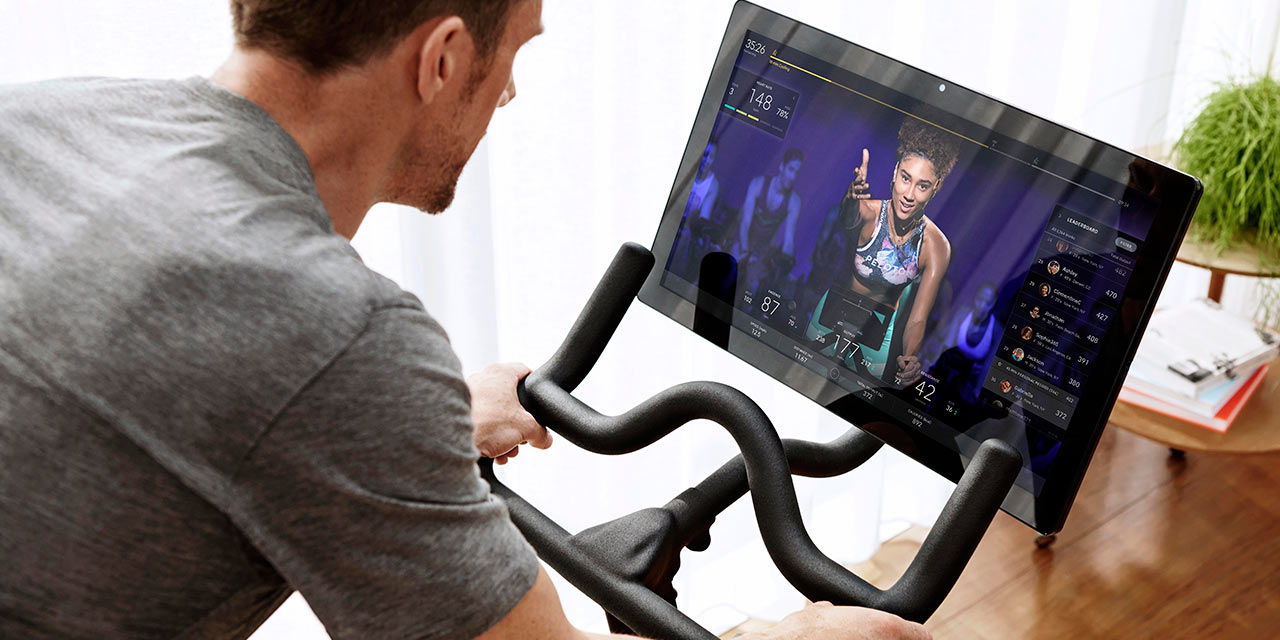 #10 What ceiling?
#10 What ceiling?
At-home workouts are just beginning to blow the ceilings off. Clubs and studios are beginning to put digital expressions of their brands into members’ pockets in response to the popularisation of Peloton and all its copycats.
Is at-home fitness here to stay? Absolutely. Is the market big. 100 per cent. At-home options will compete with in-person experiences, at least in terms of frequency.
But it’s not a binary conversation. While some consumers will prefer predominantly physical or digital experiences – many digital communities have zealots as addicted to their cause as those that meet in person – most will converse with the greater ecosystem. They will consume content when and where they choose: physically, digitally and everywhere in between.
Which brings us to point #11…
#11 Fitness is an ecosystem
The fitness customer journey is becoming borderless: physical spaces, digital offerings, online and offline communities, connective elements, crowd-sourced feedback, information and ratings… We’re able to move through our lives engaging with what we need, when we need it.
In the process, although we attach different expectations to different experiences, we remain connected to the experience provided the brand promise is met. We don’t go to a concert to hear the perfect sound production, for example – we go to be in the presence of greatness, to rub shoulders with fellow devotees and to be a part of what unfolds on that day only. Nothing beats being there. Fitness is the same. Sometimes we want the knock-your-socks-off fitness festival. Other times we just need to get 30 minutes of cardio done. We morph accordingly.
Brands need to understand and adapt to this broad customer journey, crafting experiences around all the different variables so they perfectly intersect with the natural rhythm of our lives. Those who eliminate pain points and anticipate future needs will be successful in the future.
#12 Segments are becoming finely diced
Our desire for hyper-personalisation is being met by finely diced segmentation of products and services. We can now find exactly what we want, exactly how and when we want it. We can choose the community, the instructor, the duration, the intensity, the style, the music, the metrics, the goal, the frequency, the leader board, the chat. Opt in. Opt out. It’s up to us.
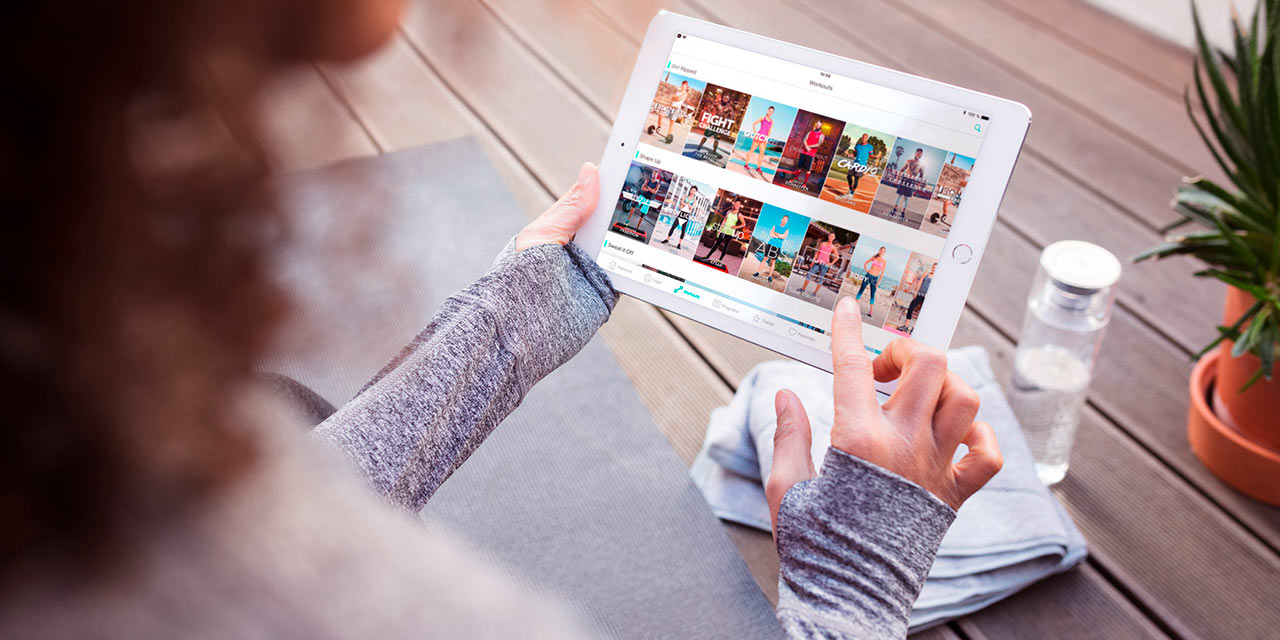 #13 Convenience-plus
#13 Convenience-plus
Back to basics: Sick kids, taking a vacation or just good old-fashioned ‘I don’t have time’ make working out at home a welcome option. But while that much has been true for decades, convenience is absolutely the currency of now.
The good news for consumers is that we’re in data-led times, with our preferences beginning to drive the products and services that are being served up to us.
#14 Fitness is leveraging star power
Think Mark Walberg and F45, Bieber and Rumble, Mayweather and Boxing, Barry’s Bootcamp and the Beckhams, Chris Hemsworth’s Centr app.
Expect the same in the digital cycling space as collaborations between databases, delivery mechanisms and stars unite.
#15 Engaging across the hemispheres
We are now borderless communities, alone-together, engaging on our exact terms with others just like us. Geography is an artificial barrier today.
Personally, my most engaging challenge this year was the MYZONE 5000-MEP January Challenge with my global fitness family. Divided by geography but united in our desire to kick-start the year, we traded on existing friendships, hemisphere rivalry, the transparency of a leader board and the usual flack you’d expect from mates in the chat. I actually won it – predominantly through daily doses of Les Mills On Demand SPRINT, in my office, at home. And I loved it.
Missed part one of the series?
For expert commentary on the latest at-home cycling news, and analysis of what all of this means for the future of indoor cycling, read the first part of the series here
And for more great insights from Emma Barry – this time sharing the secrets of success from the world’s leading boutique studios – you can purchase her book, Customer Engagement in Boutique Studios, here
Fitness, reinvented
What is your mission as a company?
Holodia’s vision statement is ‘fitness reinvented’. Specifically, our goal is to change the way the global sector delivers fitness – and with it the way people experience it – through the use of mixed reality technology.
Our focus is predominantly on VR – virtual reality – through our HOLOFIT brand. But importantly, we are not a gaming company. We’re a fitness company.
Neither are we a hardware company – we can’t compete with the R&D budgets of the big consumer brands: Oculus, HTC, Samsung, Lenovo and so on. We’re a software company, and our expertise in both fitness and software allow us to deliver new and amazing experiences to exercisers.
What is HOLOFIT, and who is the target market?
HOLOFIT is the most advanced VR fitness platform on the market.
Our primary audience thus far has been the B2B market: gyms and fitness facilities. Why? Because it takes time for new technology such as ours to gain a foothold in the consumer market. People first have to understand how the technology makes their lives better, different, more fun. We’re reaching that point now – we’ve seen VR sales growing fast over the last few quarters – so the time is now right to reach out to consumers too. We launched a fitness solution that’s suitable for home use in July of this year.
But we still have a strong focus on the B2B market. Our goal is to help gym operators solve some of their bigger problems around member engagement and retention, as well as helping them reach and attract new audiences. Crucially, we don’t see ourselves as disruptors. We’re there to help the fitness sector transform itself, and thereby strengthen its position, by embracing digital technology.
We’re also there to help gyms deliver against consumer expectations: the desire for fitness to be an experience; the desire for personal choice in how you train; and the desire to socially interact while you exercise.
So, how does HOLOFIT work?
HOLOFIT’s virtual reality software runs through a VR headset worn by the exerciser, with two versions available: HOLOFIT PRO and HOLOFIT GO.
Both offer a variety of content – what we call ‘tracks’ – to ensure personal choice in training style, workout mode and environment. And both deliver social interaction through functionality such as competitions, leaderboards and multi-player mode.
HOLOFIT PRO is designed for a dedicated VR CV zone on a gym floor: a powerful system that allows for premium visual quality. With content driven from an external, VR-ready computer, and as a wired solution, there’s no down-time: the headsets are continually charged and ready to use. It also comes with more content than HOLOFIT GO – around 120 tracks, which are regularly updated – and is priced at around €2,100 for the hardware, plus €99 per headset per month for the software and content.
HOLOFIT GO launched at the beginning of July: a wireless option that connects to compatible fitness equipment via Bluetooth. With all content stored in the headset itself, it’s a true ‘plug and play’ product for a flexible VR offering, whether in the group exercise studio, at home or on the gym floor – perfect for clubs that might not have the space or budget for a dedicated VR zone. The price tag is very different too: €850 is the retail price for the headset, plus €9.90 a month for the subscription.
The user experience of both models is highly intuitive. You simply navigate the options in the menu – avatar, training mode, track, group/individual – through your eyes, by looking at the relevant option, then start exercising in an immersive virtual world. It’s as simple as that.
even on tough cardio equipment, those using holofit keep going 2.3 times longer
What types of fitness equipment is HOLOFIT compatible with?
At the moment, HOLOFIT is only designed for use on CV equipment, but within that category we’re hardware agnostic, compatible with all major equipment brands and all types of cardio fitness equipment. I would go so far as to say HOLOFIT is the only multisport VR fitness product in the world.
That said, we focus primarily on rowers, indoor bikes and ellipticals/steppers, each of which have their own specially designed content tracks. When you look down at your avatar, they’ll be doing the same form of movement as you – rowing, cycling, running or walking.
Although technically you could use a VR headset on a treadmill, for safety reasons – you aren’t holding on to anything on a treadmill, so with a headset on you might trip – we don’t yet offer this commercially. Headsets will evolve in the future to include a small see-through membrane, and at that point treadmills will be an option, but for now we focus on ellipticals; in a VR world, using an elliptical feels like running anyway, especially if it’s on equipment like Octane’s Zero Runner.
We’re already working closely with a large number of leading suppliers – from Core Health & Fitness to Matrix, Body Bike to Concept2 – because interestingly, what HOLOFIT does is move things on when it comes to CV equipment. At the moment, the price of CV equipment is driven largely by the sophistication of the console, but when you have VR it’s no longer about the integrated screen. The combination of user + headset effectively becomes the console: the content, the experience, the social interaction, the competition, the coaching, the heart rate monitoring… it’s all done via software through the VR headset. This is an interesting shift in perspective for both operators and suppliers.
Can you use HOLOFIT with any VR headset?
Our software is compatible with most models of VR headset, but we currently recommend HTC Vive or Oculus – as I say, we aren’t hardware manufacturers, so we don’t make our own VR headsets.
That said, although we’re in continual conversations with the various manufacturers to ensure their products meet our high-spec requirements, we’re still waiting for the hardware to catch up with what we want to do – what our software could already do. With that in mind, I wouldn’t rule out creating our own HOLOFIT headset in the future.
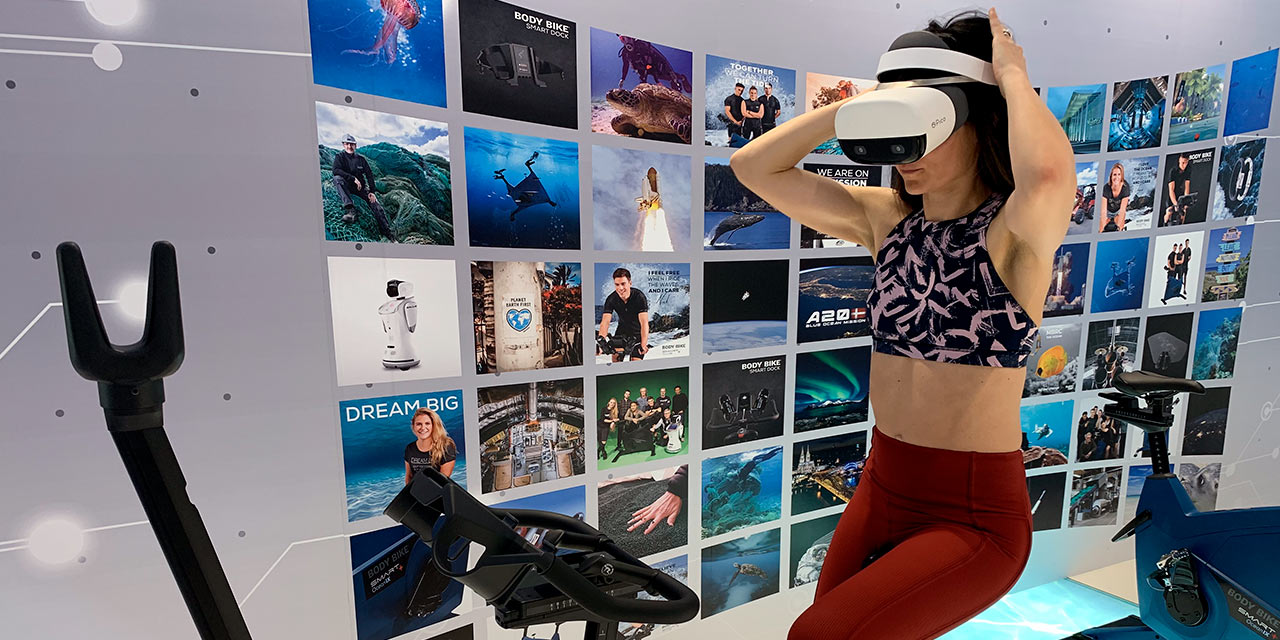
How are gyms currently using HOLOFIT?
To date, although we’re working with the likes of Anytime Fitness in the US, our focus has mostly been on smaller chains and independents where there’s more flexibility to test new concepts. We’re generally seeing clubs invest in between two and eight headsets, which are then used to monetise the gym floor, either by selling premium membership add-ons or pay as you go usage.
But we are now seeing interest grow among the bigger operators. One interesting concept is currently being trialled at Pure Gym and Basefit in the UK, in collaboration with Matrix Fitness, and at Corefit in Italy. Each operator has selected a club where they’ve created a VR Innovation Zone featuring five or six ellipticals, each with their own VR headset. These zones are running 15-minute ‘HOLOFIT Track’ interval training programmes, with the option to either timetable them so everyone starts together – members can then compete against each other, either in-club or inter-club – or, during off-peak times, make the programme available for people to drop in whenever a station becomes free.
It’s a great way of creating an engaging experience for members and monetising the gym floor, while at the same time limiting the workout to 15 minutes – our research shows that, even on tough pieces of equipment like Concept2 rowing machines, those using HOLOFIT are happy to keep going for 2.3 times longer than without it!
Finally, what we’re also seeing emerge – especially in markets like Japan, but also in Europe – are VR-only gyms. It’s still a niche area, but it’s very interesting.
What’s your model for the home fitness space?
We sell HOLOFIT GO for home use, but here our mission is different: it’s about making it easier and more fun to exercise at home.
Sitting on an exercise bike in your spare room can be uninspiring; HOLOFIT allows you to escape this boring environment, transporting you to a parallel, virtual universe. It adds a whole new dimension to radically transform the at-home fitness experience.
gyms have a choice: meet customer demand yourselves, or allow ‘bring your own device’
What are HOLOFIT’s USPs?
First and foremost, it’s the fact that we don’t just do VR. We understand VR. That’s an important distinction. Our tech team has been working in VR for around 15 years, going back to the days when a headset cost US$60,000. They specialise in the way VR technology interacts with the human brain: what works, what doesn’t, what motivates people. This is one of our USPs, and what ultimately sets those who succeed in VR apart from those who simply ‘do’ VR.
Another USP is that we’ve solved the issue of motion sickness while using VR, or at least dramatically reduced it, which all revolves around the quality of the content. We have a patent pending on this.
I also believe we have strong USPs if we look beyond VR and into the broader fitness sector.
For example, where most of the digital solutions on the market involve following a class on a big screen – but still in the environment of a group exercise studio – HOLOFIT changes the game by fully immersing people in a VR environment. It totally changes the experience.
What’s in your development pipeline?
In about three months’ time, we expect to launch a solution where you download and run HOLOFIT software through your mobile phone, clipping this into a head mount. It won’t yet offer the same quality as a proper VR headset though, because we’re waiting for the mobile phone technology – the graphics chips in phones – to catch up. That will take probably 12 to 18 months.
In fact, we’re often waiting for other technologies to catch up with what we want to be able to do! We could already create a wireless version of HOLOFIT PRO for group exercise studios, for example, but at the moment it still costs too much to run graphics through the cloud. We really need 5G for this, so I suspect it will take two years even in the fastest-developing markets to deliver this cost-effectively.
However, we don’t always run as fast as we can when it comes to product development. There’s a lot of talk about AI, for example, but we don’t believe this really exists at the moment – what exists so far are machine learning algorithms – which is why we’re happy to keep the virtual coaching in HOLOFIT quite simple for now. It’s learning and growing every day from our user data, but true AI needs a lot of data. You can’t base personalised recommendations on a handful of workouts, because such data will inevitably be skewed. We’re happy to leave this element of what we do in its infancy until we’re confident we have enough user data to understand real VR usage trends.
In the meantime, other areas we’ll be developing include VR options for weight training as well as CV equipment, and AR (augmented reality) for outdoor use. We see little application for AR indoors, where there’s far more benefit in escaping the normal – often less engaging – exercise environment altogether. But outdoors, where VR has little relevance, AR can add excitement and interaction with the world around you. That said, we still expect VR to be a thousand times bigger than AR.
We’re also exploring ways to better connect fitness with other aspects of people’s lives, because it isn’t – or shouldn’t – be an isolated activity. Within the next 12 months, you’ll be able to collect trophies while training on HOLOFIT, picking them up along the way; these will then have a monetary value in the real world, redeemable against things like workout apparel.
We may also open up to third party VR content providers in the future, provided they can create content that meets our exacting standards.
indoor cycling will have to become a lot more immersive than it is today and delivered in a far more flexible way
What do you see as the future of fitness –
and cycling specifically?
Our research shows that 70 per cent of all HOLOFIT users become regulars. This is the future. We will all have at least one VR headset in our homes. Gyms therefore have a choice: meet customer demand yourselves, or allow BYOD – bring your own device.
And indoor cycling specifically? I’m excited by the way VR could democratise this activity. I envisage small group training classes on the gym floor, opening group cycling up to anyone too intimidated to join a class full of uber-fit regulars. I envisage people using VR on their own too, not only on Spin bikes but also on more accessible models such as recumbents.
Over-arching all of this, indoor cycling will have to become a lot more immersive than it is today, and delivered in a far more flexible way. That means moving away from a fixed format – a reliance on cycling studios, external screens and live instructors – towards technology that allows for a differentiated, engaging, motivational, fun, personalised experience… because this is the experience consumers now expect.
The Digme tour
Let’s get the obvious out of the way first. The Tour de France is the most prestigious and possibly the most difficult bicycle race of the Grand Tours: 21 stages over 23 days, just two rest days, and covering around 3,500 km (2,200 miles). Each team has eight riders and the rider with the lowest cumulative finishing times is the leader of the race and wears the yellow jersey.
What’s slightly less well-known is that every year, thousands of amateurs test their overall fitness, cycling skills and nutritional strategy on one of the Tour mountain stages, a few days before the professionals come through. This event is called Etape du Tour and I’ve done two, in the Pyrenees and the Alps. My first Etape in 2005 was in the Pyrenees, where Col d’Aubisque was the main climb: 17km long, with the summit at 1,709m and a maximum gradient of 13.2 per cent. Training for this event taught me that cycling is all about numbers.
Part of the training for this personal challenge took place at Third Space Soho, where back-to-back cycling classes took place on a Friday evening. Although fun in 2005, I couldn’t measure the result as bikes didn’t have the technology and trackers were not common then. So, during the week, I had a real bike on a turbo trainer using the Billats method of speed, distance, heart rate and time in the hypoxic chamber set to 3,000m above sea level. Lactate training optimised my lactatethreshold, and over time the 4 x two-minute surges with rest intervals improved my mental toughness and my VO₂ max.
At this time, I also completed my indoor cycling certification at the London Central YMCA so I could start teaching, keen to encourage more ‘mature’ riders. I was also keen to get more from my indoor riding experience wherever I was riding, but the product was inconsistent. With Johnny G having devised Spinning in his garage back in 1989, in the process giving birth to the indoor cycling revolution, I therefore took every opportunity I could to ride with him at IHRSA, as well as on his promotional and educational tours.
While the real tour was riding into paris, i was at digme doing back-to-back-to-back rides
Going back-to-back-to-back
Given this background of road racing and being hooked on cycling indoors, I was intrigued to read about the Tour de France-themed classes at Digme, the boutique cycling studios in London and Oxford. Digme’s Tour de France event had been running coterminous with the real Tour (see ‘Digme – United in Fitness’ briefing box) and I had the opportunity to join some special riders on the final Sunday at Digme Fitzrovia.
Of course, indoor cycling classes have taken the boutique and general fitness market by storm; the talent for developing new cycle concepts seems never-ending, while over a third of private clubs – and slightly higher across the public sector sites – have dedicated cycle studios.
But what stood out in advance was the length of Digme’s ‘Perform Plus’ Tour de France event. On timetables across the sector, the most popular indoor cycling class is 45 minutes, followed by an hour. Very occasionally, programming provides the opportunity to do back-to-back for 90 minutes – but three 45-minute classes back-to-back-to-back, which was what lay in store at Digme… that will be out of most comfort zones and was a first for me. With instructor change-overs and water refills, that’s around 140 minutes in the saddle.
And so it was that, while the real Tour was riding into Paris, I was at Digme being pushed by Paul, Laura and Gareth – the instructors who shared the load through the back-to-back-to-back rides. Gareth built the final session into a crescendo of profiles which burnt the calories – over 1,500 in total – and gave me ‘des souvenirs’ of the lactate training programme. Gareth and I also had in common riding with Johnny G in the late 90s.
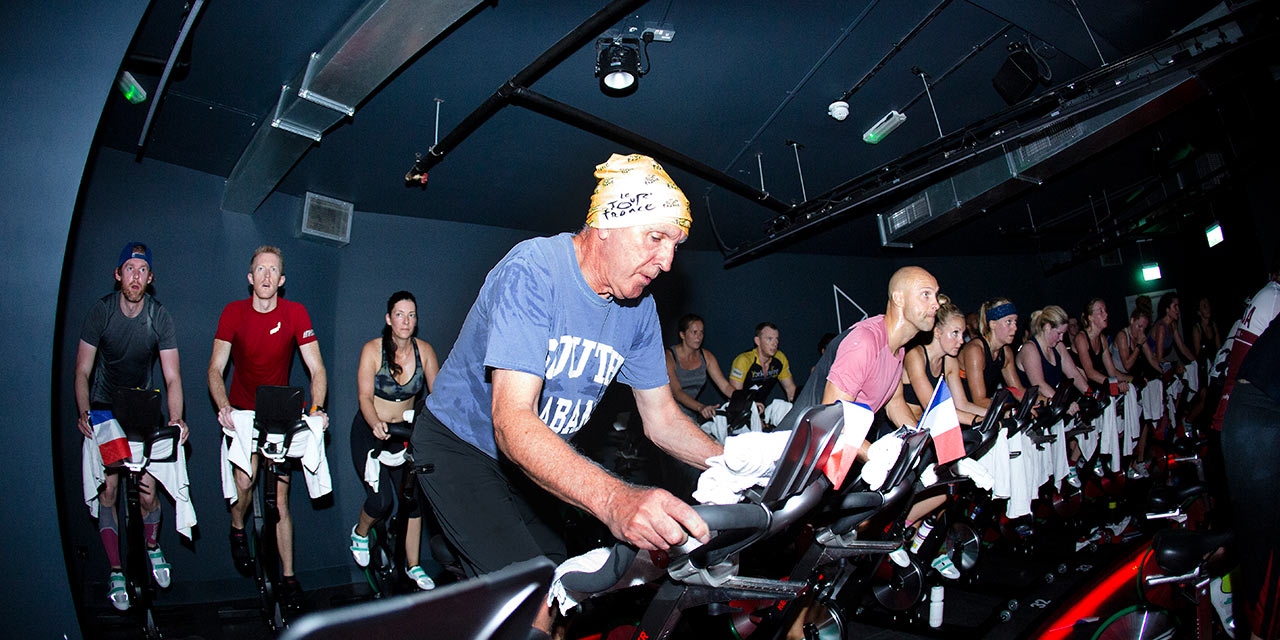 Numbers vs experience
Numbers vs experience
Digme uses Keiser M3i bikes and Spivi screens, which allows for live data to be transmitted from the bike via Bluetooth and displayed to all in the class. This in turn allows for accurate power-based training, whereby each rider in the class can ride to his or her own level based on FTP (Functional Threshold Power). It’s a great way to ensure every rider is pushed equally, whatever their power output, as well as to track progress.
Interestingly, INEOS – the sole owners of the British professional cycling Team Ineos (formerly Team Sky), whose riders came first and second in the 2019 Tour – uses the same bike-data-screen combination at its offices and plant in the UK and Europe as part of its corporate wellness offering… where classes are run by Digme’s Gareth. All the elements were in place for a great event.
However, if I might offer some constructive criticism – and appreciating this is just one person’s view – I felt the heavy focus on data rather overwhelmed the class. Of course, the regulars were aficionados of Perform Plus, which is Digme’s data-centric, performance-based class; I may well be a lone voice here! But even though the Etape du Tour taught me that training is about numbers, when it comes to classes such as this, I come from the school of enjoying the moment.
In contrast, I felt that those around me were so focused on the on-screen data that there was no scope to simply enjoy the ride. And while that might be fine in a normal class, when you’re trying to create a special Tour de France vibe… well, perhaps there might have been scope to do something different with the screen, such as showing Tour de France footage? As someone who has ridden sections of the Tour de France, I would have loved to have been challenged to climb one of the legendary climbs, adjusting my gears to match the incline on the screen in front of me.
As it was, I felt the focus was a little too heavily on data, with not enough to really tie me to the Tour de France itself.
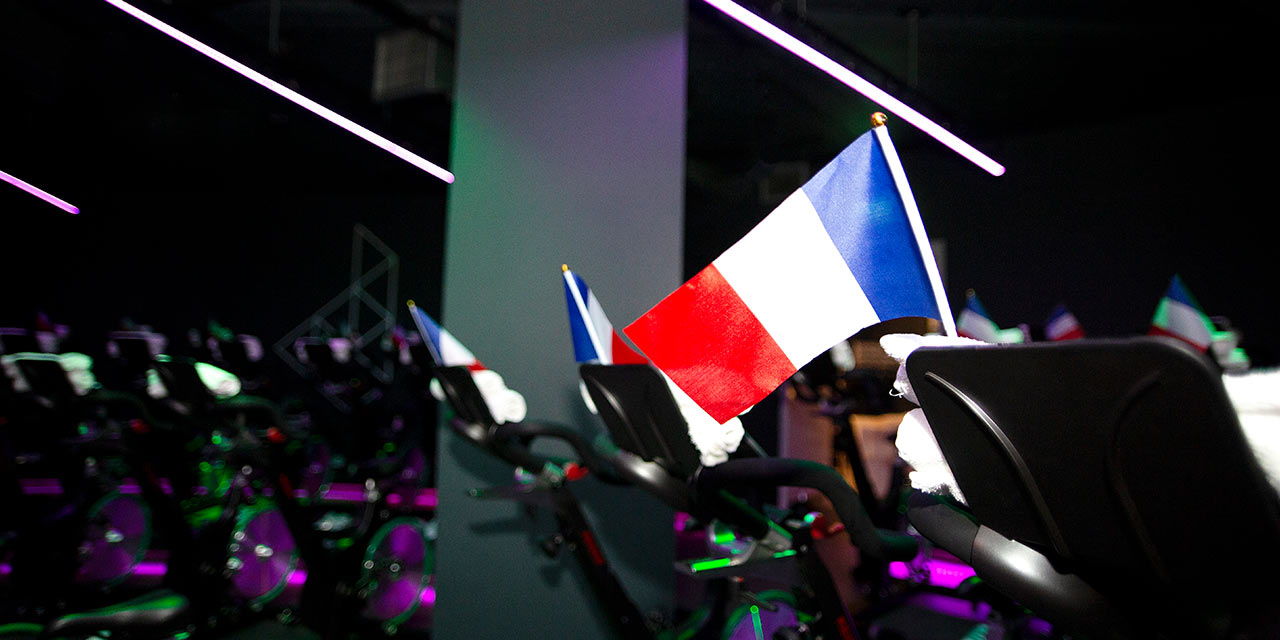 Open your mind
Open your mind
But all that is detail, and as I say just one person’s perspective, and should not take away from what was a very enjoyable event. It was also a thought-provoking one: when I told people I was doing three back-to-back classes, eyebrows were raised, but actually why not? Why not even do four? If you think about it, just one of the big climbs will take you an hour on the road. By comparison, a 45-minute class with just bits of climbing is nothing. Digme therefore has to be praised for this – for opening people’s minds to the possibility.
And Digme delivers all of this in a very achievable way. The Tour de France event wasn’t one long class – it was three separate, back-to-back classes with different instructors, each with their own style. Why shouldn’t other clubs and studios structure their timetables so there are three or four classes in a row, allowing members to do multiple consecutive classes if they wish?
why shouldn’t other clubs or studios run three or four classes in a row, and tie it all around a theme?
And absolutely, why not tie it all around a theme? There are plenty of other fantastic Grand Tour events to link to; Digme already runs themed classes around events such as the Giro d’Italia. Food for thought for other operators out there.
So, my main take away is this: let’s have more back-to-back programming, and back-to-back-to-back classes at weekends please. Great fun, and thanks for the ride Digme.
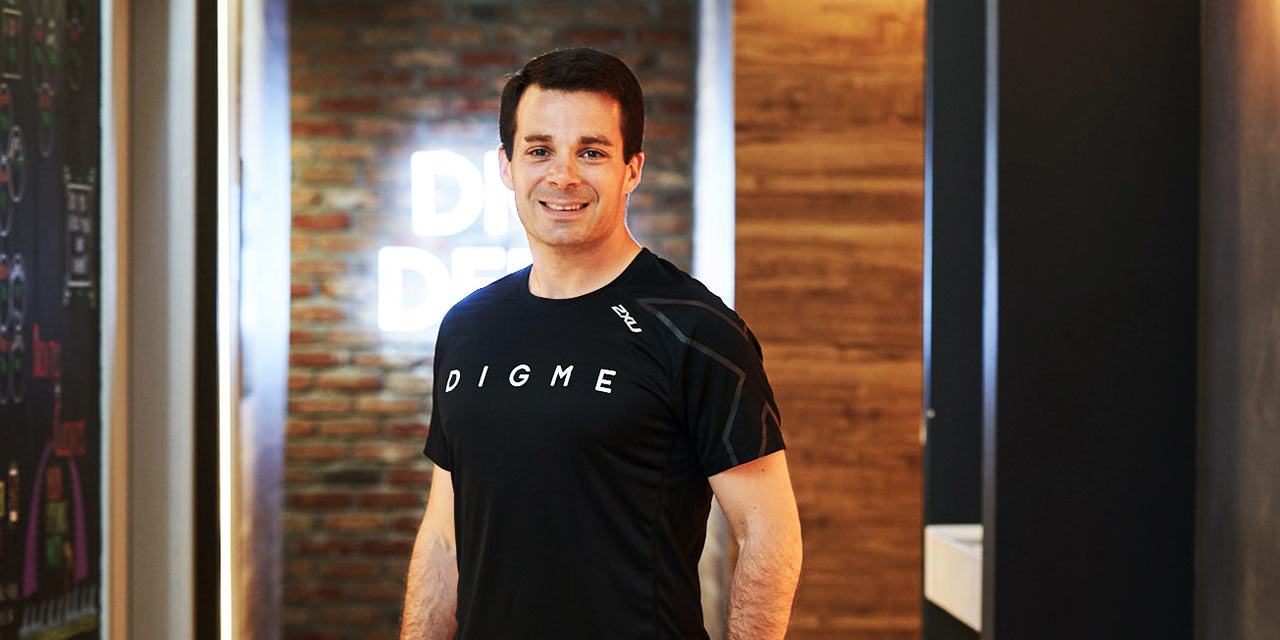 Digme: united in fitness
Digme: united in fitness
Geoff, please set the scene: what is Digme all about?
Digme offers a diverse range of world-class, authentic indoor cycling and HIIT classes in an inclusive, community-focused environment – one where you can track and measure your workout.
We’re there to help people make a positive change: to be healthier, happier and to achieve their best self. We encourage customers to set their sights high, achieve more than they ever expected and leave feeling exhilarated and in the best shape of their lives.
Whether you want to get lost in the music and ride to the rhythm, track your fitness using data, or experience an exhilarating HIIT class, we have something for you. It doesn’t matter if you’re a first-timer or a fitness fanatic: we represent fun, accessible fitness where you’ll dig deep to achieve your goals.
What was the idea behind your recent Tour de France event?
Digme has a really motivated, inclusive community and we love bringing that community together – especially for a workout!
each week, our members tackled a different stage of the tour de france
We have some very talented riders who join us for Perform Plus classes – our data-centric, performance-based cycling sessions – week in, week out. We knew they would love to be involved in a series of themed classes based on the Tour de France, taking their workouts to a whole new level.
What did the event involve?
We ran Ride the Tour sessions workouts in our Perform Plus classes throughout July, culminating in a special Tour de France event at our Rathbone Square studio on Sunday 28 July. All sessions were designed by our world-class Perform Plus instructors Paul, Laura and Gareth – themselves impressive cyclists, triathletes and Ironman finishers.
Each week, members tackled a different stage of the Tour de France, with time trials, epic climbs, sprints and challenges to mirror stages of the tour. Stage one – Pau – was an individual time trial. Stage two – Saint Jean-de-Maurienne to Tignes – was short but intense, with lots of climbs. And stage three – Embrun to Valloire – included a trio of classic Tour de France climbs: Col d’Izoard, Col du Galibier and Col de Vars.
There were lots of prizes up for grabs, including jerseys for the furthest distance travelled across the three stages; the most sprint points gained; the highest average watts per kilo on the challenges; and the best young rider (under 25 years). There were also team awards – the furthest combined distance travelled for male, female and mixed teams – and an award for the gutsiest effort during each class. There were also spot prizes of much-coveted yellow socks up for grabs – for best effort made, someone’s first class, and so on.
Finally, our 28 July event celebrated the end of the Tour de France with a specially curated 140-minute class. This was followed by a post-workout French-themed party, a Ride the Tour awards ceremony and a screening of the Tour de France finale.
Do you organise events on a regular basis?
On the first Thursday of every month, we run Climb n Cleats in our Moorgate, Richmond and Oxford studios – a 60-minute Perform class themed around a different legendary climb from around the world each month.
We also run themed classes for the major tours, such as the Giro d’Italia.
What is the value to the business of events such as this?
Bringing the Digme family together to train is what makes Digme so special, and events are fantastic tools to do this. Diggers are brilliant at bringing fun, energy and enthusiasm to push themselves to new highs.
Digme Fitness currently operates five studios in the UK, with four in London – Rathbone Square, Moorgate, Blackfriars and Richmond – and one in Oxford.
The appliance of science
What makes for a great group exercise class? Pose that question to a group of class enthusiasts and you’ll no doubt be offered a wide range of answers: great instructors, inspirational music, engaging choreography, exciting AV…
But to focus purely on the experience is to miss one vital factor – and that factor is RESULTS. You might be able to make a class fun, but how many people would do it if they weren’t also likely to get fitter, lose weight, improve their health?
That’s why, even with its decades of group exercise expertise, Les Mills International continues to invest in extensive research – research to prove the effectiveness of new programmes and establish compelling ways to speak about them, but also studies to help it continually improve existing programmes.
Within this, cycling has been a key focus – and the research has paid dividends, leading to the successful expansion of Les Mills’ portfolio of indoor cycling programming. Now, alongside RPM, cycling enthusiasts can also benefit from HIIT cycling concept SPRINT and immersive experience THE TRIP.
“Our research has highlighted that, by offering a variety of different programmes, cycling can accommodate people of very different levels of fitness and exercise experience,“ confirms Bryce Hastings, head of research for Les Mills.
And Hastings believes such research shouldn’t be left behind the scenes. “Clubs should always be looking for new ways to promote the benefits of cycling to members, and sharing these kinds of research findings is one way to do that,“ he says.
We take a look at some of the research that shaped RPM, SPRINT and THE TRIP.
ADherence to training was more than 95 per cent – really high for previously inactive people
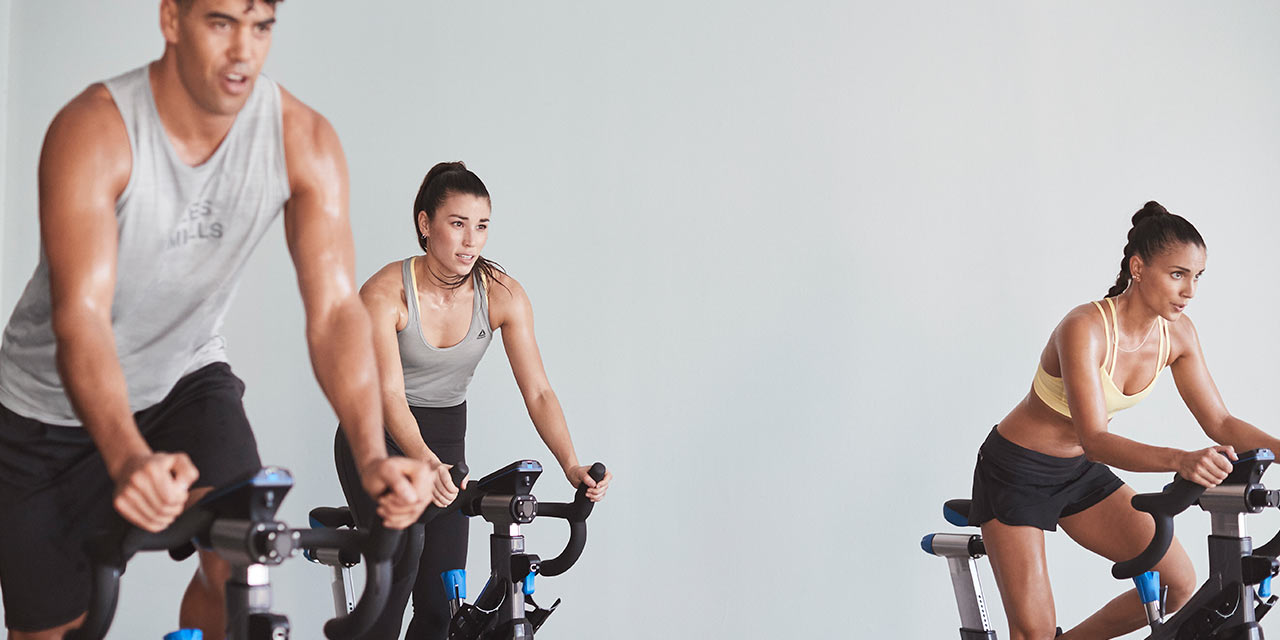 RPM: Lowering the risk of heart disease
RPM: Lowering the risk of heart disease
“We wanted to investigate whether group cycling could reduce the risk of cardiovascular disease in a group of sedentary individuals,“ explains Hastings. “In particular, we were interested in the
effects of what we call cardio peak training – varying levels of intensity off a sustained aerobic base.
“We were also interested in whether cycling in groups could improve compliance.“
The study was conducted at Loughborough University in the UK in 2015, and set out to study the effectiveness of an eight-week studio cycling intervention – conducted in a group environment – on improving the cardio-metabolic health of previously physically inactive, overweight adults.
“We hypothesised that VO₂ max, blood lipids, blood pressure, body composition and glycaemic control would be improved following the intervention,“ adds Hastings.
The methodology
Eight overweight, physically inactive – defined as doing less than 1.5 hours’ activity a week before the intervention began – but otherwise healthy volunteers completed eight weeks of supervised studio cycling lasting 20–50 minutes, three times a week for eight weeks.
Participants underwent assessment for maximal oxygen uptake (VO₂ max), body composition, blood lipids, glucose tolerance and insulin resistance before and after the intervention.
The findings
First and foremost, adherence to training was more than 95 per cent – and participants reaped the rewards. VO₂ max (aerobic fitness) increased by 12 per cent, while body fat percentage was reduced by 13.6 per cent. Total cholesterol was reduced by 12.5 per cent, and LDL cholesterol – the type of cholesterol that contributes to plaque formation in the arteries – was reduced by 30 per cent.
“The compliance rate – attending 95 per cent of the prescribed workouts – was really high for this type of group,“ observes Hastings. “This was possibly due to the group environment, but crucially, it was instrumental to the success
of the intervention in reducing cardiovascular disease risk.“
“A nearly 10 per cent increase in VO2 max for a group who are already fit is impressive“
SPRINT: Get your cycling HIIT
“We had seen great results from Les Mills GRIT, our series of HIIT workouts that combine high impact bodyweight and resistance exercises,“ explains Hastings. “We wanted to investigate whether we could achieve similar results with a non-impact form of HIIT, namely Les Mills SPRINT, which is carried out on a bike.“
Conducted at Penn State University in the US in 2015, this study was based on a hypothesis that a six-week intervention – where trained individuals replaced one 60-minute bout of moderate cardiovascular training with two 30-minute bouts of HIIT cycling – would improve health and fitness more than maintaining their moderate-intensity cardiovascular exercise routine.
The methodology
In this study, 36 trained adults were randomly
assigned to one of two groups: Group HIIT or Group FIT.
Group HIIT participants replaced a single 60-
minute cardiovascular training session with two 30-minute high-intensity indoor cycling sessions for a period of six weeks. Meanwhile, Group FIT maintained their current training routine.
The researchers measured blood pressure, peak oxygen consumption, fasting blood profile, body composition and leg strength before and after the intervention.
The findings
The HIIT intervention significantly improved all variables except HDL cholesterol. Peak oxygen consumption and leg strength increased significantly for the HIIT group – these individuals saw increases of 9.7 per cent and 11.9 per cent respectively – but not the FIT group.
Meanwhile, there were significant decreases in the HIIT group for blood pressure (down 9.9 per cent), fasting blood glucose (down 7.0 per cent), total cholesterol (down 6.0 per cent), LDL cholesterol (down 7.8 per cent) and triglycerides (down 16.3 per cent). Fat mass also dropped by 1.1 per cent for the HIIT group.
“I’m always impressed with how fast HIIT works,“ comments Hastings. “A nearly 10 per cent increase in VO2 max for a group who are already fit – in just six weeks – is impressive.“
He adds: “The other reassuring component of this research was that you don’t need to jump around doing high impact exercise to reap the rewards of HIIT training. A class like Les Mills SPRINT is accessible to anyone who wants to take their fitness up a notch.“
THE STUDY FOCUSED ON EXERCISE INTENSITY AND PERCEIVED EXERTION
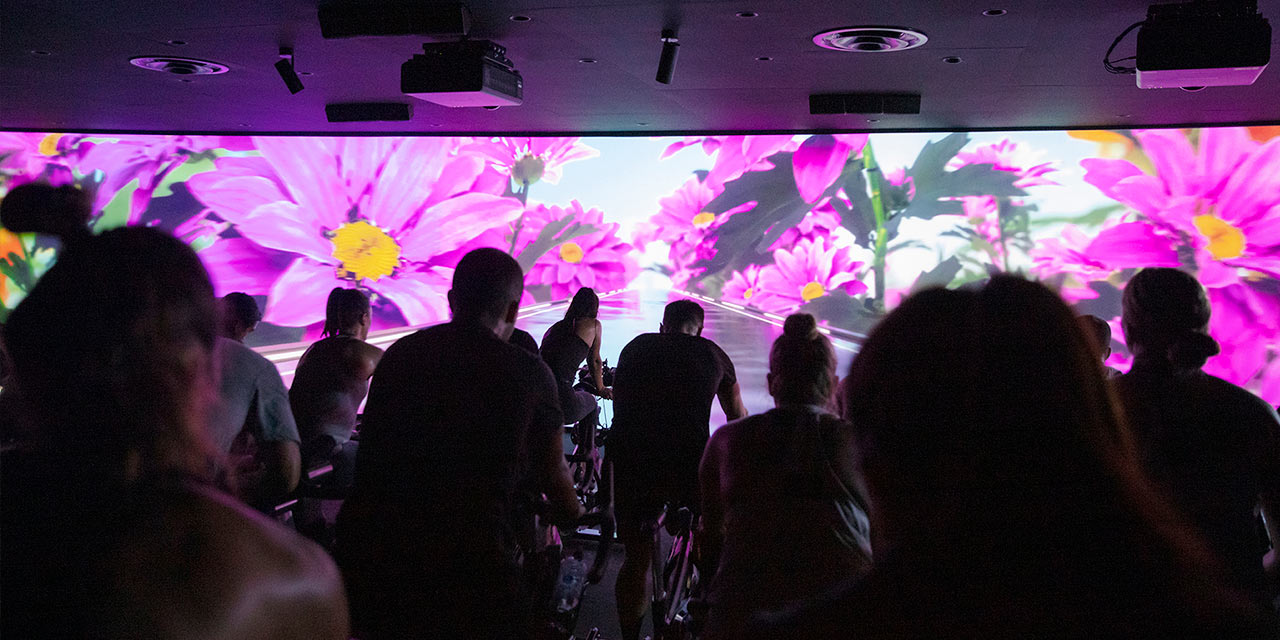 THE TRIP: Immerse yourself
THE TRIP: Immerse yourself
“We’ve previously published findings on the various motivation styles instructors might use in a cycling environment,“ says Hastings. “These findings indicate that the old ‘bootcamp’ style of instruction may not be the best method.
“One of the key factors that increases the chances of someone adopting an exercise habit is simply a sense of enjoyment. It is this that shifts novices from exercising because they ‘have to’ to exercising because they want to, which in turn makes it more likely they will keep up the habit.“
Les Mills was therefore keen to explore new ways of motivating members, and it developed what it believed to be a world-class solution: its immersive, audio-visually spectacular TRIP classes. This was then put to the test in a scientific study.
“This study was designed to explore what adding this visual experience would do to the cycling intensity, and the perceived exertion of the workout, among novice cyclists,“ says Hastings.
“We already had good data that group cycling workouts delivered key health benefits – as noted in the RPM study above – but what effect would adding a visual stimulus have?“
Conducted at Penn State University in 2017, the study therefore set out to investigate the impact of the immersive qualities of THE TRIP – specifically, whether those immersive qualities increased the intensity of a person’s workout without them noticing how hard they were pushing themselves.
The methodology
Tests were conducted on a group of 20 novice fitness participants. Over an eight-week period, they completed eight audio-only group fitness cycling classes and eight immersive classes (featuring digital imagery matched to the music).
The study focused on two variables: exercise intensity and perceived exertion.
The findings
The results showed the novice group’s rate of perceived exertion (RPE) – that is, how hard they thought they had worked out – was less doing THE TRIP than when doing the audio-only class, when in fact the intensity was the same.
“This investigation indicates that THE TRIP is an ideal group fitness environment for relative newcomers, to help them achieve their fitness goals,“ says Hastings.
“Cycling studios in general are a great avenue for beginners. There is very little technique involved, so perceived competence levels are high right from the start. But what this research shows is that adding a visual stimulus can reduce perceived intensity, which we believe can also help beginners. The element of ‘exertainment’ reduces the sense of discomfort and encourages people to adhere to cycling classes in the early stages of developing an exercise habit.“
He adds: “Exercise intensity has been highlighted as a key factor that can impact compliance in early exercisers: if those new to exercise feel they have had to push themselves ‘too hard’, they may be less likely to return. With THE TRIP, they get into a higher heart rate zone to get fitter, faster, but without feeling the discomfort of this intensity level.“
And on this topic, Hastings has further advice to offer beginner cyclists – and the clubs and studios catering for them: “Starting gradually is key, focusing on frequency and consistency before intensity.
“In fact, we’ve found that giving people the licence to leave a class when they have had enough, and slowly adding tracks as they get fitter, helps them establish an exercise habit.“
Rick Crawford
“Across the fitness sector, the advent of the boutique studios has forced big box gyms to up their game,“ says Rick Crawford, head of fitness at Nuffield Health, the UK’s leading not-for-profit healthcare organisation. “The boutiques threw a spotlight on the weaknesses of the larger operators, highlighting where they simply weren’t up to scratch when it came to group exercise.
“In terms of cycling, for example, it’s no longer enough to have a group of bikes in a traditional studio. That isn’t what people want. What people are looking for now is an immersive experience.
“In fact, thanks to the boutiques, this isn’t just what they’re looking for. It’s what they now expect. If we don’t have the right product in our gyms, our members want to know why.“
Experiential gym floors
He continues: “All that said, our innovation in this area hasn’t been a knee-jerk response to the boutiques. Cycling has long been our most popular group exercise class at Nuffield Health: across our 112 consumer clubs, it accounts for around 15 per cent of all classes – that’s over 2,000 group cycle classes each week. Within this, we’ve always placed huge importance on staying ahead of the game.
“We were one of the first operators in the UK to introduce the concept of wattage onto gym floors, for example, working with Wattbike. Now everyone has it, but when we started five or 10 years ago, people were joining our clubs especially for this. Cycling as a whole was enjoying a boom, driven by the likes of Team GB’s Olympic success, and there was suddenly a demand for science to be brought to indoor cycling: wattage, marginal gains, technique to maximise power. A new generation of indoor bikes that far more accurately replicated the experience of riding outdoors only added to this momentum. And what we were doing at Nuffield Health met all those needs, allowing cycling enthusiasts to train with us in a way that complemented what they were doing outdoors.“
gym floors aren’t just about equipment. they’re about experience and social connection
Nuffield Health’s gym floor model has since continued to evolve, as Crawford explains: “We’ve made ongoing investments in transforming our fitness spaces, adopting new layouts that encourage people to find the experiences that best suit them.
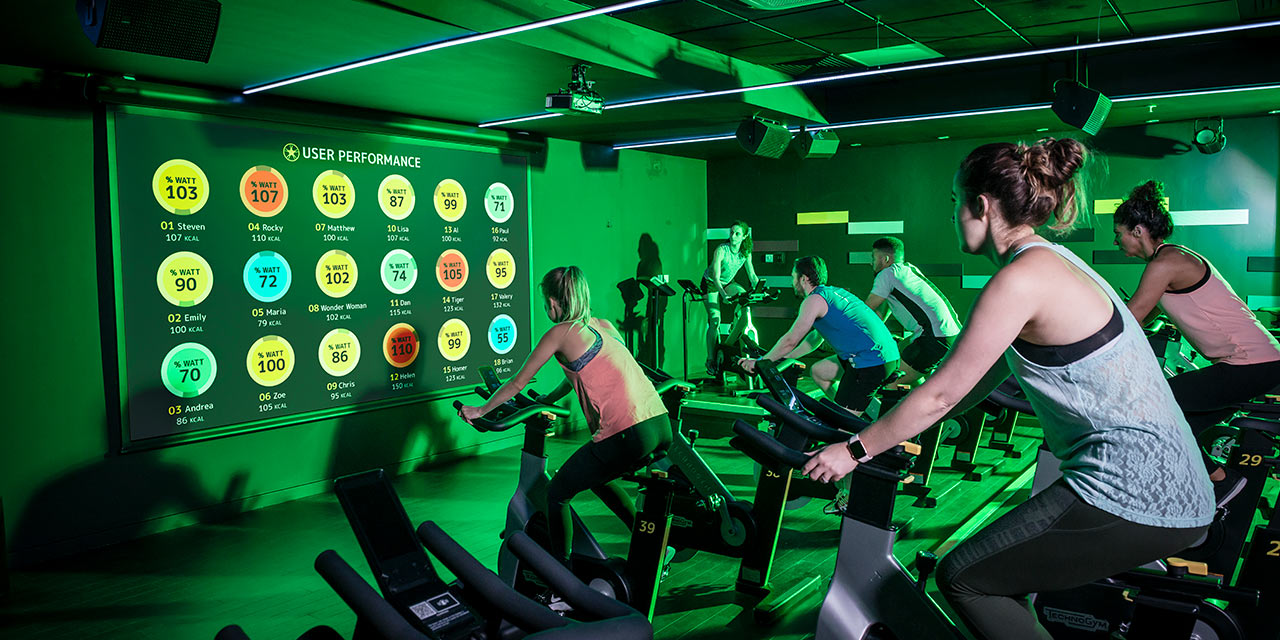 “Within that, there’s a big focus on creating different zones: cycling, rowing, running. We did our first ever zone – which was a cycling zone – around seven years ago and now we’re creating them in every club we can, because gym floors are no longer just about equipment. They’re about the experience too, and about social connection. People don’t want to train alone any more.
“Within that, there’s a big focus on creating different zones: cycling, rowing, running. We did our first ever zone – which was a cycling zone – around seven years ago and now we’re creating them in every club we can, because gym floors are no longer just about equipment. They’re about the experience too, and about social connection. People don’t want to train alone any more.
“Each cycle zone holds between three and eight bikes – typically Wattbike or Technogym’s Skillbike – and can be used for individual training. However, the primary focus is small group training, with typically three or four instructor-led sessions on offer every day. These classes are built around the training modalities of speed, stamina and power, with all of the data from the bikes projected onto a big screen.“
He adds: “To work to their full potential, the zones need human interaction. That’s why small group training is so key. But the other vital aspect is the need to offer a variety of class types to appeal to different members. Gym floor classes are a great way to get new people to try cycling, so while all the technique and data-focused classes appeal to cycling enthusiasts, we also offer things like HIIT classes for those who just want a workout that will burn through the calories.“
You can’t just do one standard cycling class and expect it to appeal to everyone
A segmented offering
This diversity of class offering has also extended into Nuffield Health’s group exercise studios, by way of its NuCycle portfolio of programming. Originally launched in 2017, NuCycle will be available in around 40 of Nuffield Health’s clubs – both consumer and corporate – by the end of 2019.
“Cycling needs to do fitness, performance and exertainment,“ explains Crawford, as an introduction to the NuCycle concept. “You can’t just do one standard fitness cycling class and expect it to appeal to everyone. You need a breadth of classes for different types of customer.
“Based on customer research, we came up with six distinct programmes that were not only deemed ‘cool’, but that were also inclusive – very important for an operator like Nuffield Health, where 45 per cent of the membership is aged over 55 years.
“All six programmes are available in all clubs with NuCycle, and start with NuCycle Edge at the performance end of the scale. This class is all about data, efficiency, power, heart rate, competition.
“Then there’s Les Mills’ SPRINT, a 30-minute HIIT class on a bike that’s ideal for anyone looking for an intense workout in a shorter timeframe. Les Mills’ RPM is also in the mix, catering for members who want a traditional fitness cycling class.
“And then we have NuCycle Rhythm, which is most easily explained by comparing it to SoulCycle. We turn off all data, all power monitoring, and there’s no hint of competition. Instead, it’s all about fun, great music, an enjoyable 45–60 minutes of cycling. It’s entertainment. This is where the growth is, attracting new audiences who just want to have fun.“
He continues: “The final two classes are NuCycle Baseline and NuCycle Escape. Baseline is there to onboard beginners, getting them familiar with the product – it’s a great, inclusive way of getting people started. But equally importantly, Baseline involves a fitness test. If you’re going to do training that’s based on power, intensity and threshold, you need to do a fitness test to know where you stand. Baseline is therefore worth doing periodically too, to see how you’re progressing.
“Finally, NuCycle Escape is virtual cycling: virtual classes led by an instructor, as well as Les Mills’ immersive experience THE TRIP. This is a great category for so many reasons: you can run it all day if you need to, which means far less dead time in your studios; it attracts beginners because it’s less intimidating; and in our corporate sites especially, where people might be on shifts that mean they can’t come to live classes, it means members get to train with the world’s best instructors – even at very much off-peak times.
“Interestingly, we’re finding Escape also helps us fine-tune our schedules. At one of our big corporate sites, for example, we found so many people coming in for a 3.00pm cycling class that we’ve now turned it into a live instructor-led class.“
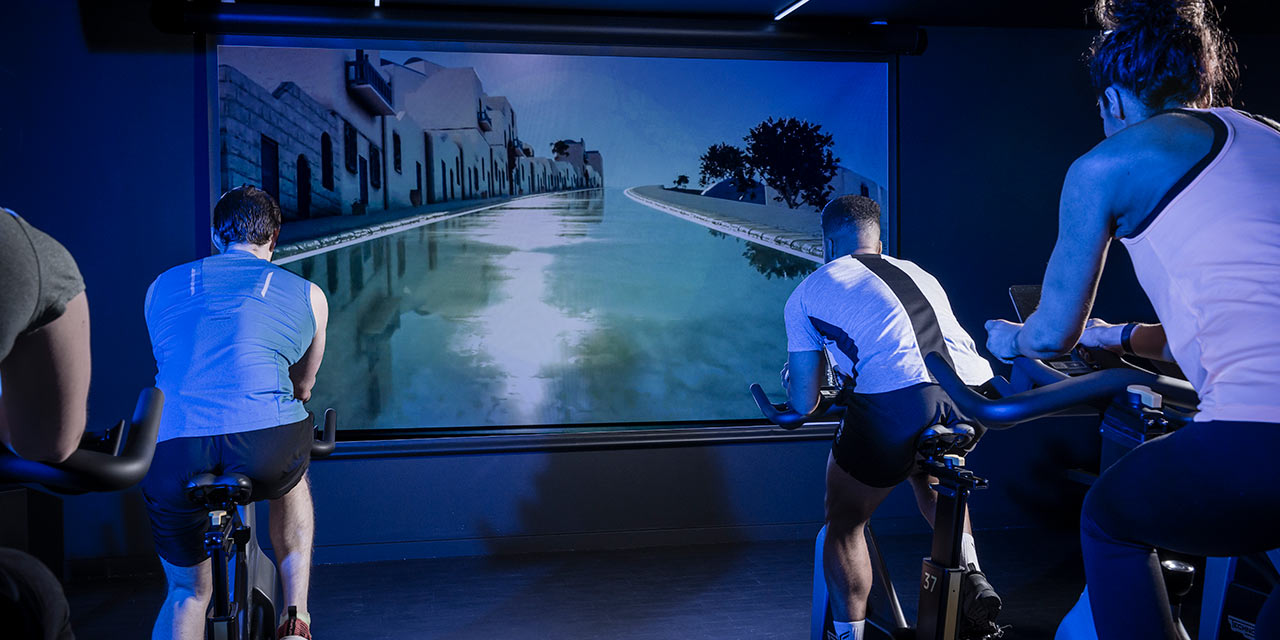 What’s in a name?
What’s in a name?
Linking all of these distinct programmes together, the NuCycle umbrella brand is important, says Crawford: “It’s not often that Nuffield Health allows for sub-brands to be created, but the business absolutely saw the value of this when it came to NuCycle.
“In a way, it goes back to the boutiques. It was important to create an identity for our cycling offering, with a coolness about it that would stand out in the market.
Nucycle is definitely one of the coolest things we’ve done over recent years
“And NuCycle is definitely one of the coolest things we’ve done over recent years – not just the programming, but the studios too. We’ve worked with AV specialists to install fantastic sound systems, plus lighting that responds to the music and the workout intensity. Design has gone far beyond the traditional wooden floors and mirrors too, with inspiration coming from all sorts of unusual sources. Some of our studios make you feel like you’re cycling on the road, for example, with hi-vis strips running down the walls and dark floors that look like tarmac.
“It all comes together to create a fun, flexible environment that allows our instructors to deliver great classes.“
Speaking of instructors, has Nuffield Health found the types of instructor they recruit changing in response to the new class formats? “Certainly different instructors perform better in different types of class,“ agrees Crawford.
“Edge, for example, requires someone who’s very technique-focused and data-savvy, while Rhythm needs the instructor to be an entertainer. We’re proactively going round our teams looking for highly interactive individuals, who we then train up to be cycling instructors for our Rhythm classes.“
He adds: “I’d actually love all of our fitness staff to be teaching group exercise, whether small group training or studio classes. In my view, while personal training is still important, the days are gone when you could say ‘I only do one-to-one’. One-to-many is the way things have to be now. All trainers need this skillset.“
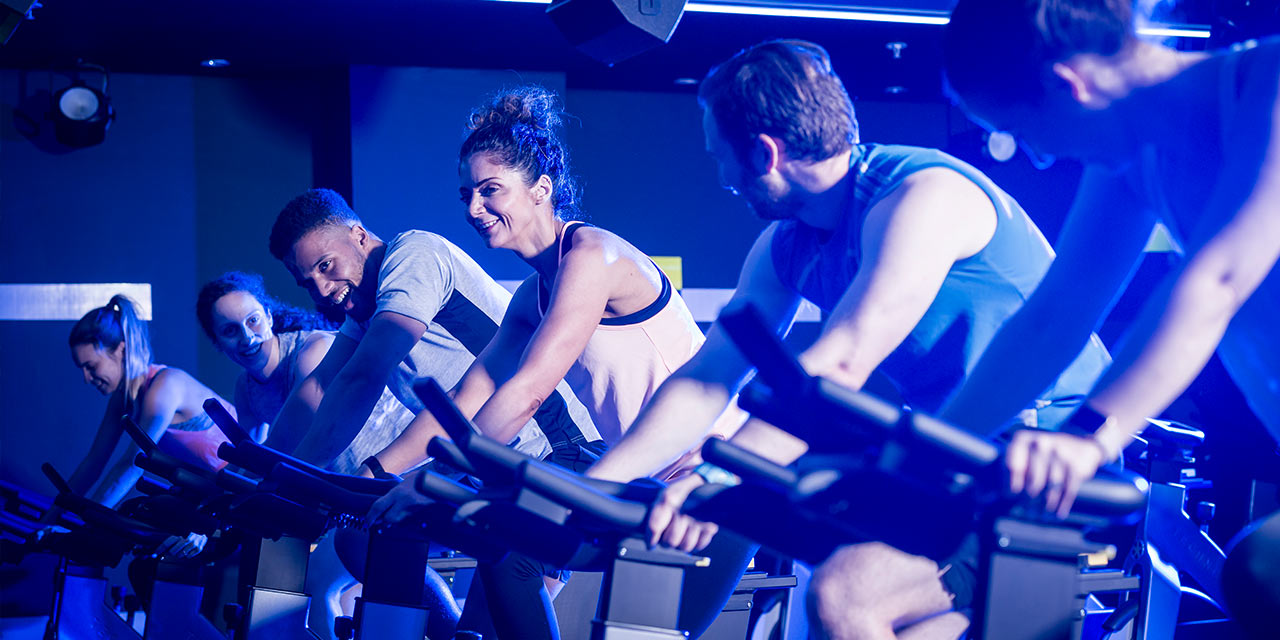 Limitless potential
Limitless potential
So how has NuCycle performed so far? “Exceptionally well,“ says Crawford. “In all the clubs where it’s launched, we’ve seen our Net Promoter Scores rise, the number of leavers fall and the number of new joiners increase, with great feedback from staff and members alike. But it’s not just about member satisfaction – we’ve also seen cycling class occupancy levels go up by around 14 per cent.
“Unsurprisingly, then, all the other clubs in our estate are keen to have NuCycle too. We’re looking at how we can roll it out to as many sites as possible over the next few years.
“It’s also entirely possible that we’ll expand the programming choices within NuCycle. There’s so much we could do here, and this is only going to grow as the fitness demographic continues to segment, with ever more diverse needs that have to be met. Provided we’re able to tap in to a large enough group of members, with a compelling proposition that’s relevant to them and that delivers good outcomes, I see huge scope to launch new classes.
“I can easily see how we might introduce a meditative NuCycle class, for example, targeting emotional wellbeing – this is a huge focus for us at Nuffield Health, where we will have an emotional wellbeing expert in every club by the end of next year. We could have NuCycle Recovery. We could have a joint pain class. We could have a NuCycle class for those with diabetes. We could do something even more targeted around active ageing, as cycling is great for this audience: non-weight bearing, fun and social.“
He adds: “With our medical expertise and direct links to Nuffield Health hospitals, we could work with physios to create programmes for pre- and post-operative patients too. This is where live streaming technology could even come in, putting our classes direct into patients’ homes.
“While we aren’t currently looking at implementing these ideas, there are so many possibilities. I’m always looking for the next thing to ensure we keep up with customer demand across all segments of the population.
It’s all about content nowadays, making your content available digitally
“In fact, as a charitable organisation, one of Nuffield Health’s key principles is social impact: how we can reach more of the people who need us. And in this respect, in this digital era, it’s all about content. Not everyone wants to come to a gym, so you have to look at how you can make your content available digitally. Of course, there are only so many new initiatives you can introduce at any one time, but this is definitely something I would like to do.“
Colin Grant
How would you describe The Pure Group?
The Pure Group is a premium lifestyle brand whose vision is to inspire and help people to lead healthier, happier lives.
Our health club brand is Pure Fitness: large, premium clubs with a full offering across the board of programming, facilities and member experience. We’re very happy with the big box model. People aren’t one-dimensional, and the size of our facilities gives us the space we need to meet all expectations when it comes to wellbeing. It allows us to create a true 360° offering and gives us the flexibility to innovate and adapt to new trends.
It was eight years ago, for example, that we first introduced a large, turfed functional training area into one of our Pure Fitness clubs in Singapore; five years ago that we brought gymnastics to the gym floor in Hong Kong; 10 years ago that we started incorporating large lounge areas to promote a sense of community. We’re constantly looking to break down barriers, innovate, try new things. We try to look ahead and anticipate customer needs.
And Pure Fitness is just one part of our Group. Meanwhile, Pure Yoga – which, as a standalone offering, was in itself quite innovative when we first launched in Hong Kong in 2002 – offers every style of yoga, as well as meditation.
We have in-house nutritionists in Hong Kong and are expanding the team in Singapore and Shanghai too; alongside our healthy-eating nood food brand, this is an area we will continue to develop and grow. For example, we’re currently looking at options for home delivery of meals, in combination with personal training.
We’ve also brought in a sleep specialist recently and are already looking to recruit a second. Sleep is critical to wellbeing, but today sleep is where nutrition was 10 years ago: in a few years’ time, the invaluable contribution it makes to our health won’t even be questioned, but at the moment people are only just starting to really pay attention to it. I’m very excited about this field – it’s going to be a big one for us.
In fact, our sleep specialist and our nutritionists are already looking to work together to develop programmes which, combined with special yoga classes and personal training, will offer members a holistic package to improve the quality of their sleep.
Across our Group, then, we aim to have all the elements in place to help people live healthier, happier lives, delivering it all at a premium level and with great customer service.
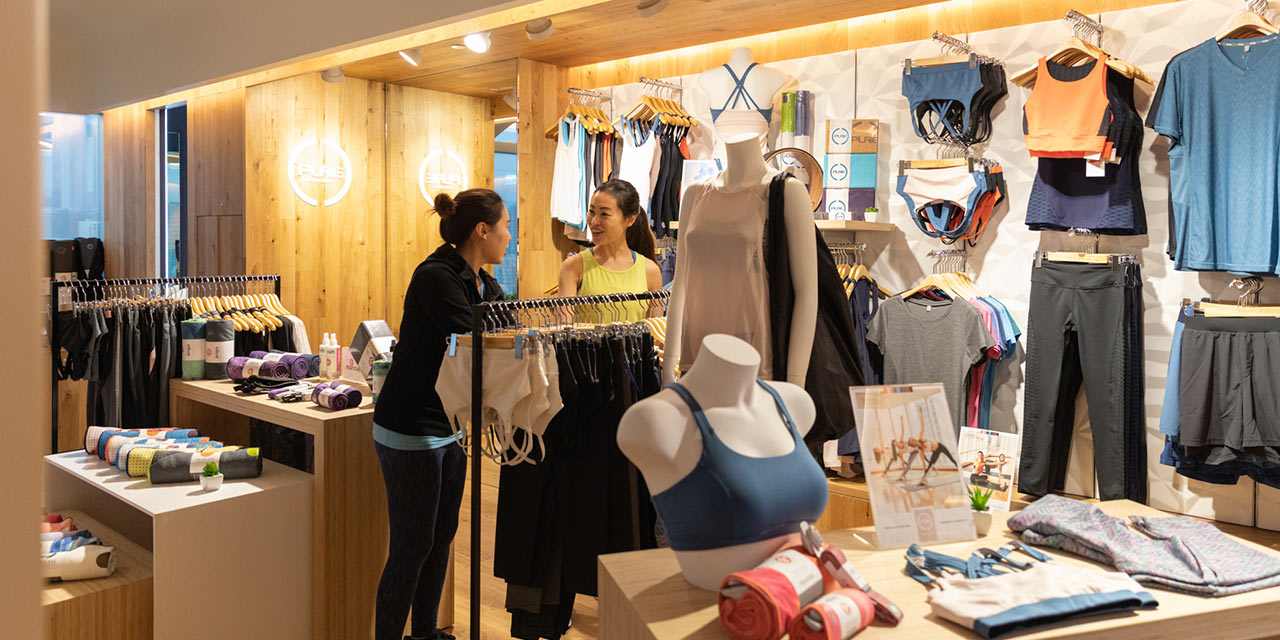 How have you kept your cycling offering competitive as the boutiques have emerged?
How have you kept your cycling offering competitive as the boutiques have emerged?
Around 26 per cent of our gym members take part in group exercise. Of those, around 20 per cent do group cycling, so it’s an important element of what we offer.
Back in 2015, we launched the world’s first 270° Les Mills TRIP studio – the immersive cycling experience [read more here] – at one of our clubs in Hong Kong. That’s done incredibly well, to the point that we now put it in wherever we have the opportunity: we’ve already done similar installations in Singapore, as well as two clubs in Shanghai.
In fact, we’re still the only operator in the world to have 270° screens – there are four in the world and we have all of them. But I absolutely believe it’s worth the investment: with the screen all around you, you’re totally immersed in the experience. People love it: most of our TRIP classes have waitlists and it’s attracting even those who wouldn’t normally be drawn to cycling. We also offer it as part of the membership – there’s no extra charge for TRIP classes.
We’re experimenting with cycling studio design at our new club in Singapore too, with a tiered atrium-style layout, best-in-class sound system and far more scope to add interesting lighting effects. We then have the option to replicate and retrofit this into our other cycling studios.
Another new initiative is a collaboration with Technogym at our newest club, One Taikoo Place in Hong Kong, which opened in August of this year. Every one of our clubs has a different feel, a different personality, and at One Taikoo Place we’ve brought gamification to the gym floor. We’ve created a gym floor zone – equipped with Skillbikes, Skillmills and Skillrows – where we run competitive virtual triathlons: cycling, running and rowing. It’s created a real buzz, with some great member feedback already.
we have to act small, human-sized, ensuring that every member is looked after
How important is technology to delivering the experience members want nowadays?
It’s one aspect, certainly, but not the only one. At The Pure Group, we talk about being hi-tech and hi-touch: personal interaction is key, especially at the premium end of the market.
In the case of indoor cycling specifically, you have to bear in mind that – while innovations such as the TRIP bring new people to the discipline, and while great lighting for example will engage people – there are some hardcore cyclists who just want to get on a bike and go… and it will be these people who will still be with you in 10 years’ time. The trick is to cater for both groups without being gimmicky or short term, understanding that what really keeps people coming is the quality of the instructor. You need instructors who love what they do.
We do bring in technology where we feel it will enhance the member experience. We launched our Innovation Lab a couple of years ago, where we test new products in our clubs. It gives our members a chance to try out the latest innovations, provides great feedback for the supplier, and allows us to trial the latest products before we commit.
We’ve also built our own software – it’s been a three-year project – which we’re calling Pure 360. It’s our own club management system that’s integrated with both a member app and a staff app. This will further enhance in-club interaction as well as providing personalised support out of the club. If you book a yoga class in the club, for example, mypureyoga.com – our online virtual class platform, which will also be integrated into Pure 360 – will
recommend complementary, online classes run by the same instructor.
But equally, there’s some evidence of tech fatigue nowadays: many people like to come to the gym to escape their screens for a while. So, what matters are our staff: 90 per cent of our staff are customer-facing and they’re there to provide the personal contact – across the 25,000 visits to our clubs every day – that will keep bringing those members back.
They also lie at the heart of our community, which even outside of our clubs goes far beyond the online realm. We run events, we organise wellness retreats, we form tribes – Latino Familia, the Handstand Clan and so on – who are all united by a particular interest.
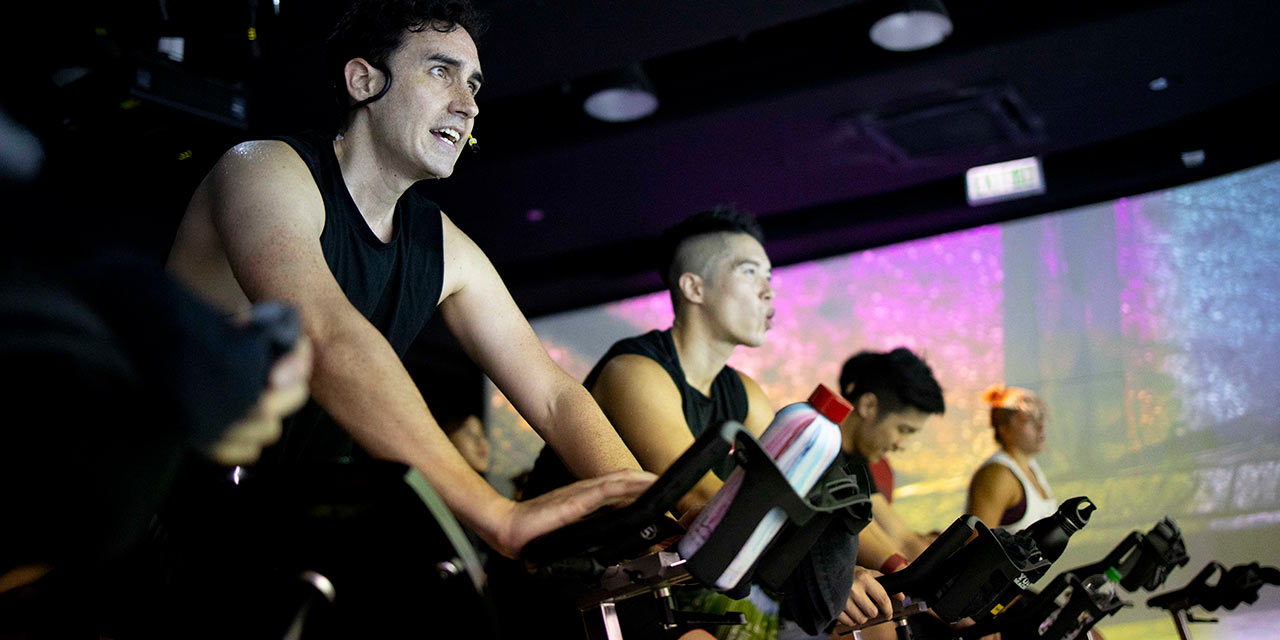
in selected locations in-club boutiques will offer Hiit, cardio, functional and boxing
The way I always explain it, our size can be an advantage and a disadvantage. The key is to not act big. We have to act small, human-sized, ensuring that every member is looked after so well they feel like they’re the only person in the club.
To what extent have you embraced the
at-home fitness market?
We obviously have mypureyoga.com, and our app will allow us to provide members with at-home workouts and support. But, while we have of course noted the growth of Peloton and the at-home market generally, at this stage we aren’t venturing into our own hardware. It’s still very early days in this field, and hard to know who’s really doing it well.
We also have more than enough to keep us busy in our existing business. We only have 36 clubs – of which 34 are operated by us – so there’s plenty more growth opportunity for our club model.
While we would never open new locations for the sake of it – they will always have to be great locations and a great space, allowing us to create a fantastic club – I expect to open a dozen more clubs in Hong Kong, Singapore, Shanghai and Beijing over the next 12 to 18 months. We’re certainly finding that landlords are now actively looking to bring wellbeing brands into their developments above, for example, the big retail brands.
Any other new innovations at The Pure Group?
We’re seeing a trend towards the creation of boutique studios inside big box gyms, and we’re currently exploring options to develop something similar for our own clubs. We’ll be looking to launch this new concept in selected locations in Hong Kong, Singapore and Shanghai.
These in-club boutiques will offer a mix of disciplines – HIIT, cardio, functional, boxing – with a range of programmes on offer. These will be both adaptations of our own small group training concepts, as well as hand-picked pre-choreographed sessions.
Would you consider opening standalone
boutique studios?
We’ve considered it for a long time, contemplating what we might do that would complement our big boxes, but in the end you can’t be all things to all men.
There’s also the question of where we are in the boutique lifecycle. I wouldn’t like to hazard a guess, but if even the big brands like Flywheel are closing sites… perhaps we’re better off staying focused on our big box model. While I don’t like to play it safe, and will always experiment with new ideas, I certainly don’t feel compelled to jump in and do something just because
everyone else is.
It’s also the case that you get a much better deal on a lease if you want 30,000sq ft versus 4,000sq ft. That makes the small box model a particularly hard one to crack, especially in Asia where rents are already among the highest in the world. Even our Pure Yoga locations – although they have the feel, the energy and the community of boutiques – measure 15,000–20,000sq ft.
What do you believe is the future of
indoor cycling?
It will certainly continue to be a big part of the gym experience, but I do believe – all innovation aside – that what will ultimately keep drawing people back won’t be lighting or sound systems or décor. It will be better and better instructors.
People will all but ignore the surroundings if they have an instructor they really connect with. That isn’t unique to cycling of course, but it is something to keep in mind, and the reason why staff training is always at the top of our investment priorities.
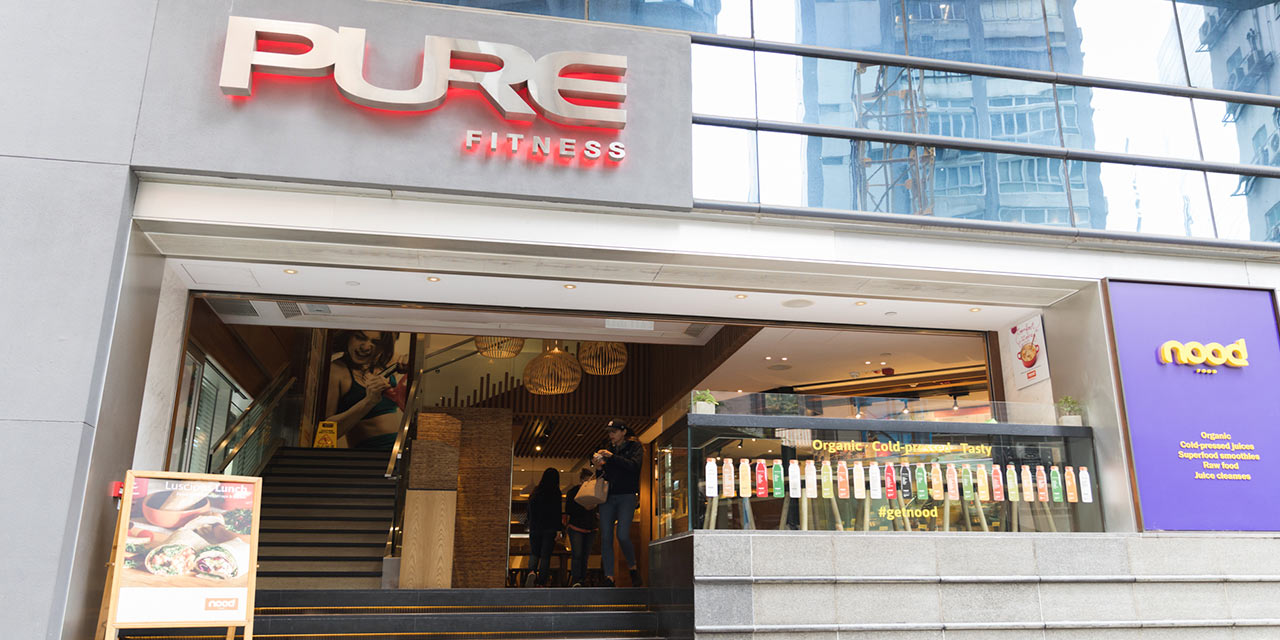
About the pure group
Founded in 2002 and headquartered in Hong Kong, The Pure Group is Asia’s leading premium lifestyle brand that includes Pure Yoga, MyPureYoga.com, Pure Fitness, Pure Nutrition, Pure Apparel and nood food. Pure Group has locations in Hong Kong, Shanghai, Singapore and New York – the latter a licence agreement with Equinox.
As at August 2019, the Group catered for over 80,000 customers across 36 sites. Most are either Pure Yoga or Pure Fitness, but one site – Hong Kong’s The Pulse – offers both Pure Fitness and Pure Yoga in one location.
The Group’s 22 Pure Yoga clubs are located in Hong Kong (12), Singapore (four), Shanghai (three), New York (two) and Beijing (one). Meanwhile, of the 15 Pure Fitness locations, 10 are in Hong Kong, with three in Singapore and two in Shanghai.
SoulCycle London: Our verdict
The anticipation has been understandable: this is a brand which, since it opened its first studio in Manhattan in 2006, has built an enviable fan base including the likes of Beyoncé and Jay-Z, David and Victoria Beckham, Lady Gaga, Madonna, Khloe Kardashian and Michelle Obama. And SoulCycle’s appeal reaches beyond the celebs, with an impressive 20,000 people taking classes every day across its 90+ studios.
 I myself had previously done SoulCycle in Los Angeles and had been wowed by a feelgood factor that – to my non-performance orientated mind at least – still stands head and shoulders above other indoor cycling workouts I’ve done. I had loved the focus on fun, on getting a sweat on but as a side-effect of having a great time.
I myself had previously done SoulCycle in Los Angeles and had been wowed by a feelgood factor that – to my non-performance orientated mind at least – still stands head and shoulders above other indoor cycling workouts I’ve done. I had loved the focus on fun, on getting a sweat on but as a side-effect of having a great time.
I had loved the darkened studio and the candlelight. I had loved the infectious exuberance of the instructor; goodbye English reserve, hello infectious positivity and happy vibe.
I had also loved the fact that, while encouraged to crank it up, I had been left to strike my own balance between enjoyment and exertion. SoulCycle really had lived up to the two halves of its name: the mental benefits for me were as great as the physical, and I left with a smile on my face and a spring in my step.
I was, then, understandably keen to see how the experience would translate and settle in the UK.
Energy Boost
As it turns out, work-weary as I was when I turned up for my Wednesday 6.30pm class,
I would have settled for anything that boosted my energy levels a bit.
Fortunately, SoulCycle didn’t stop there.
From the moment I walked into the light, bright reception area – staffed by a team of around eight front-of-house staff – it felt unmistakably SoulCycle. But what I was really interested to experience, of course, was the workout itself… and it’s great to be able to report that SoulCycle London brings the same positive vibe, the same ability to make 45 minutes pass quicker than any other cycling class I’ve ever done, as I experienced in the States.
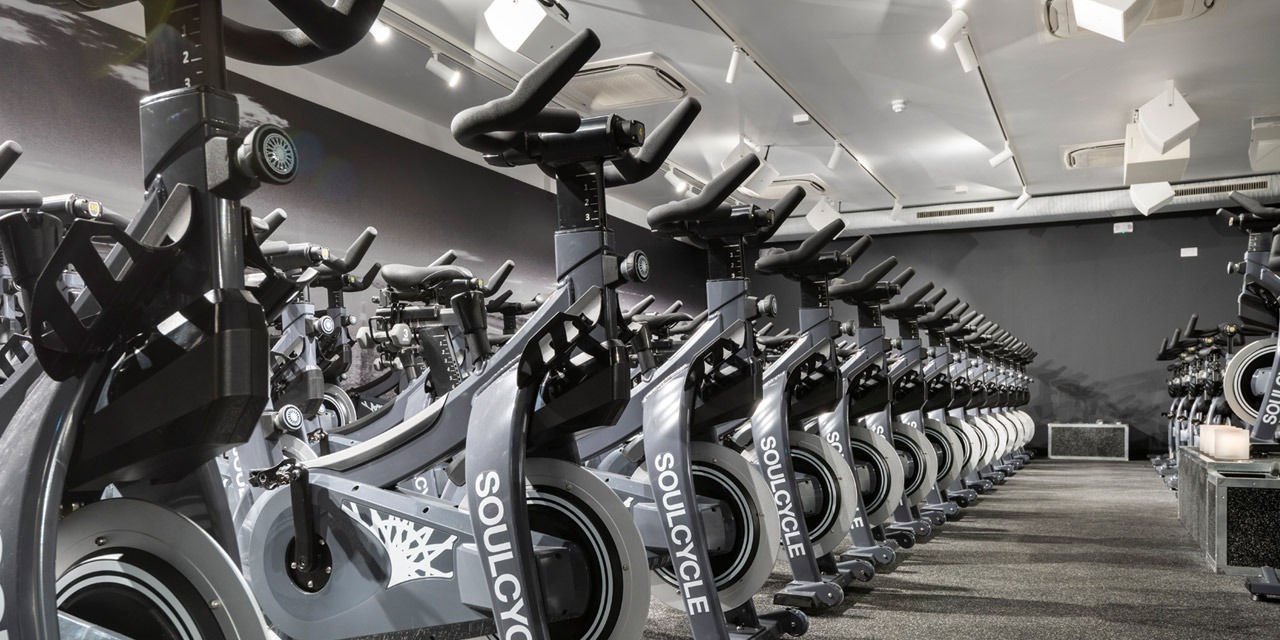 The London studio is packed full of 63 SoulCycle-branded bikes, including some set off to each side of the instructor. No space given up that could be filled with a bike. But that’s the same formula as in the States, and it certainly brings an energy into the room – not to mention a good amount of sweaty ‘I’ve worked hard, I can feel good about that’ heat.
The London studio is packed full of 63 SoulCycle-branded bikes, including some set off to each side of the instructor. No space given up that could be filled with a bike. But that’s the same formula as in the States, and it certainly brings an energy into the room – not to mention a good amount of sweaty ‘I’ve worked hard, I can feel good about that’ heat.
it’s ok to be there for a good time, not necessarily a ‘train until you drop’ time.
Then there’s the fact that the darkened studio – lit by candlelight and, intermittently, by uplighters around the instructor – makes you feel somehow enclosed in your own space, focused not on those around you but purely on yourself, the great music and the instructor on the podium. The other bikes in the room honestly don’t matter once the lights go down.
Star quality
And so to the instructor – such a key element in justifying SoulCycle’s £24 a ride price tag. On the podium for my class was the bubbly Lauren Naomi, one of the London studio’s three UK instructors; the other three have been ‘imported’ from SoulCycle in the US.
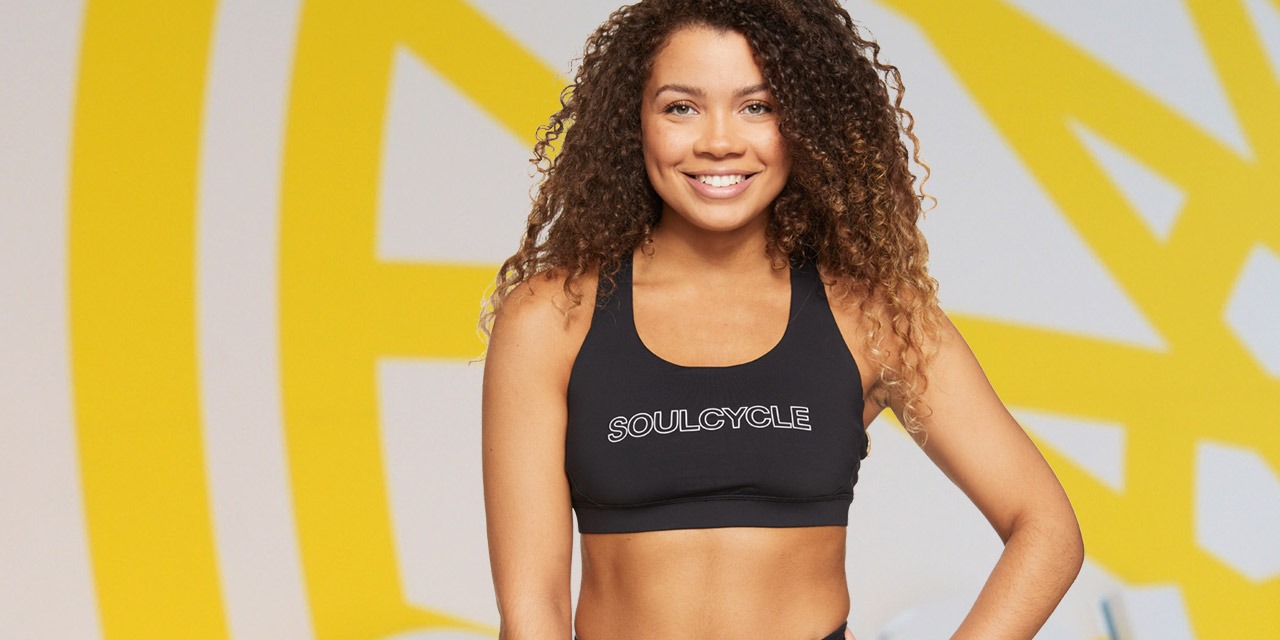
Straight away, two things were evident. Firstly, no instructor is allowed in front of a class until they’ve completed full training in the US. There’s a unique way of doing things at SoulCycle and Lauren Naomi oozed it.
Secondly, SoulCycle’s recruitment policy is clearly personality first, cycling experience second – and I say this not because Lauren Naomi didn’t smash it in the saddle. I say it because her positive, encouraging presence at the front of the room felt very natural while still outgoing, no doubt due to the fact she’s also a professional singer, dancer and actress. This is someone who’s used to being in front of a crowd.
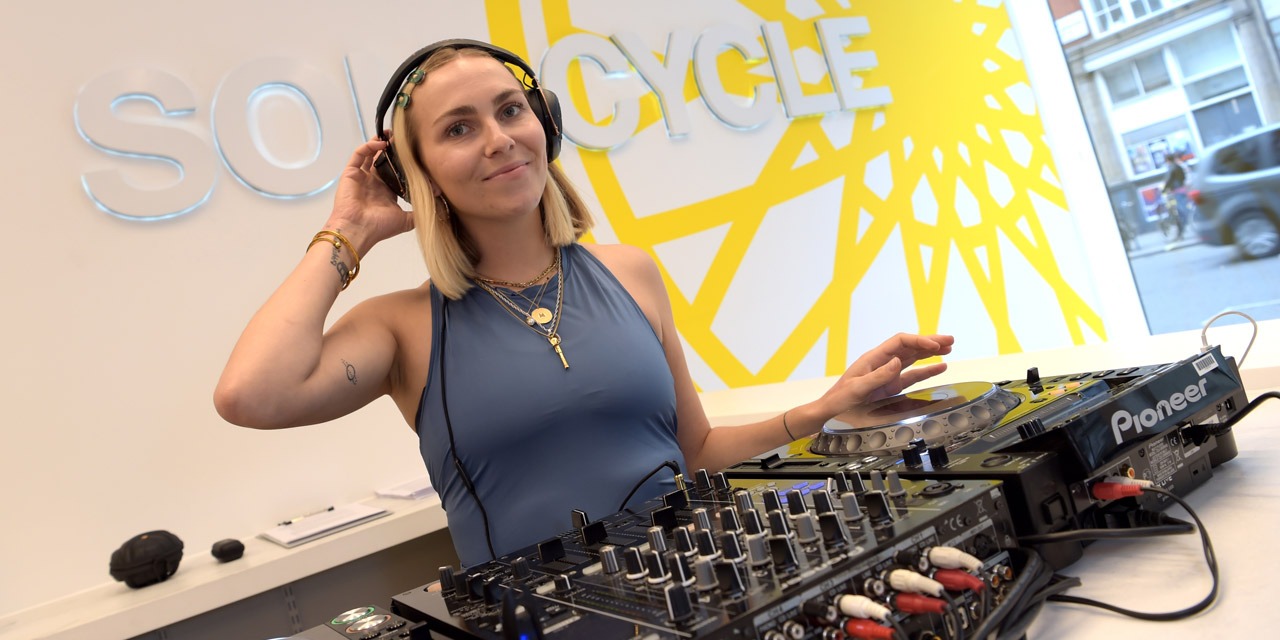 I also say it because of her very honest, and with it very engaging, comment at the end of the class to those struggling to disengage their cleats: “Don’t worry. I hadn’t even got on a bike until I went to the States for my SoulCycle training. The first class I did, I was still stuck in the corner on my bike when everyone else had left the room!”
I also say it because of her very honest, and with it very engaging, comment at the end of the class to those struggling to disengage their cleats: “Don’t worry. I hadn’t even got on a bike until I went to the States for my SoulCycle training. The first class I did, I was still stuck in the corner on my bike when everyone else had left the room!”
It was all very natural, very engaging, very encouraging – “as long as your legs are still moving, you’re doing great”. Ultimately, very SoulCycle. It was OK to be there for a good time, not necessarily a ‘train until you drop’ time… just get a sweat on, get a bit out of breath, but have a smile on your face too – don’t take things too seriously. Immerse yourself in the tunes and the moment and dance your way through the class.
The cult of Soul
Interestingly, while around half the class were on their first ever SoulCycle ride – with its price tag of £16 to get people in and hooked – a good number were already regulars just one week in to the studio’s lifetime, committed to multi-ride packages: buy 30 rides as a package and the price comes down to £19 per class; a 10-class package brings the per-class price down to £21.
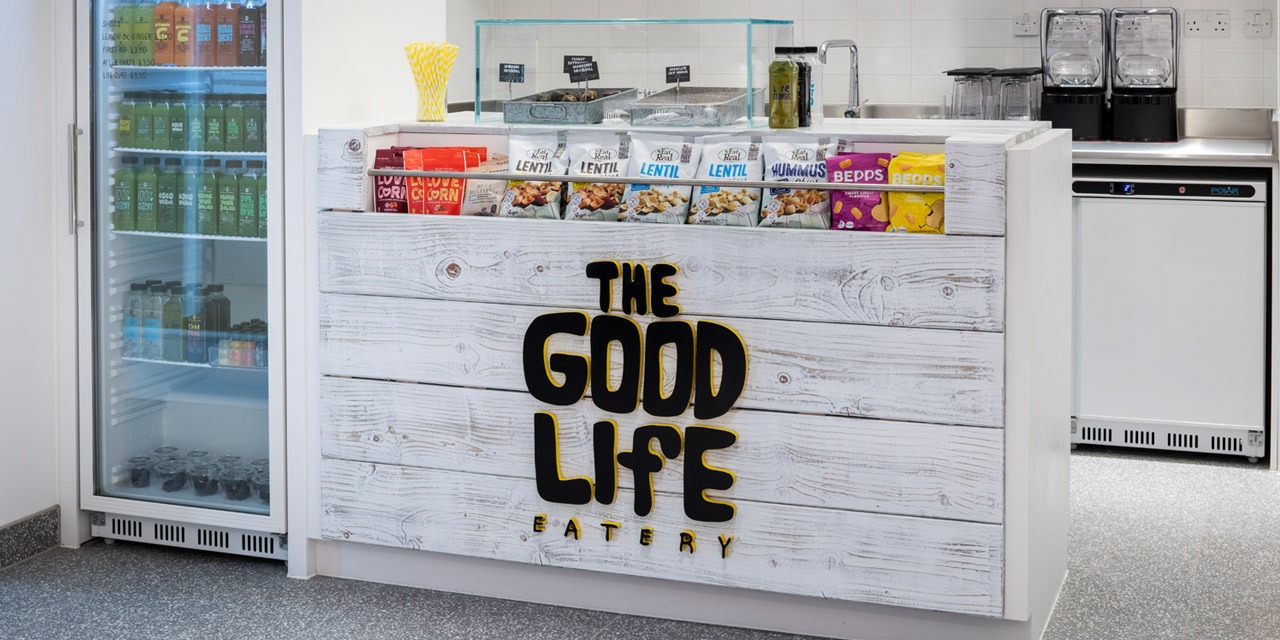 But however, people are buying their classes, whatever their level of commitment, buying them they most certainly are. The eight classes taking place on most weekdays, and the five a day at weekends, are filled almost as soon as they open for booking; some wait lists for the next day were, I was told, already 30-strong. People are champing at the bit to get in, and with the levels of engagement already being shown, it seems to be more than a novelty factor.
But however, people are buying their classes, whatever their level of commitment, buying them they most certainly are. The eight classes taking place on most weekdays, and the five a day at weekends, are filled almost as soon as they open for booking; some wait lists for the next day were, I was told, already 30-strong. People are champing at the bit to get in, and with the levels of engagement already being shown, it seems to be more than a novelty factor.
is London ready for Soulcycle and its £24 classes? the answer appears to be ‘yes.
So enthusiastic are they, in fact, that some of the already-regulars in the class – unprompted by Lauren Naomi, who was comparatively restrained in her “come on Wednesday!” cheerleading – indulged in a bit of spontaneous mid-class whooping. The American enthusiasm of SoulCycle is, it seems, infectious.
To those many observers asking the question ‘is London ready for SoulCycle and its £24 classes?’… the answer appears to be a resounding ‘yes’.
About SoulCycle London
Location
3–4 Great Marlborough Street, London
Size
3,500sq ft of cycling studio + retail space
Bikes
63
Price
£24 for a one-off class;
packages also available
Food & beverage
The Good Life Eatery
Oliver Schulokat
How would you describe CYBEROBICS?
The CYBEROBICS brand stands for a high-quality digital training experience. Our virtual group exercise classes allow users to work out with the best trainers in the US, at the most breath-taking locations and do so entirely flexibly – whenever and wherever they choose. Plus, it’s all tailored to their personal training goals, their preferences and their individual training level.
Our ultimate mission is to harness the power of digital technology to make it possible for more people, all over the world, to enjoy fitness training and thus make regular exercise a natural part of their lives.
What is your model?
We originally launched CYBEROBICS in the B2B segment, with a focus on fitness studios, corporates and hotels. In 2018, we took the bold step of addressing the B2C segment by launching a CYBEROBICS app, which is now available in 21 countries.
We offer a training experience that’s fun, enduringly motivating and easily accessible.
This is the path we’re going to pursue in future – a combination of B2B and B2C – because we’ve seen that the two segments complement each other really well.
What is the opportunity you see for CYBEROBICS?
Fitness training is a wonder-drug: it maintains health, gives you energy in your everyday life, lifts your mood and keeps you feeling good. I believe everybody wants to work out. It’s just that some people aren’t able to motivate themselves to train regularly – to make it a firm fixture in their everyday lives. That’s where CYBEROBICS comes in. We offer a training experience that’s fun, enduringly motivating and easily accessible, which means people are much more likely to choose to integrate it into their everyday lives.
As a digital product, it’s also very convenient – it can be used any time, anywhere – while its attractive price point and flexible contract models make it very accessible.
All these factors add up to the huge potential for CYBEROBICS in the fitness market.
How important is the digital nature of the product?
I see a very clear trend towards increased use of digital products; people no longer work out at the gym alone.
The aim has to be to offer a digital product directly within the club which members are also able to use outside of the club.
In my opinion, there are two main reasons for this. Firstly, the younger generation – I like to call them the ‘on-demand generation’ – is used to having things precisely when they want them, regardless of time or place, thanks to the ubiquity of digital media and devices. That’s how it is in other parts of their lives, so they expect it in fitness too, and that expectation will only grow over the next few years. I’m sure there will always be fitness studios, but people will combine working out at the gym with training at home in a way that fits perfectly with their everyday lives.
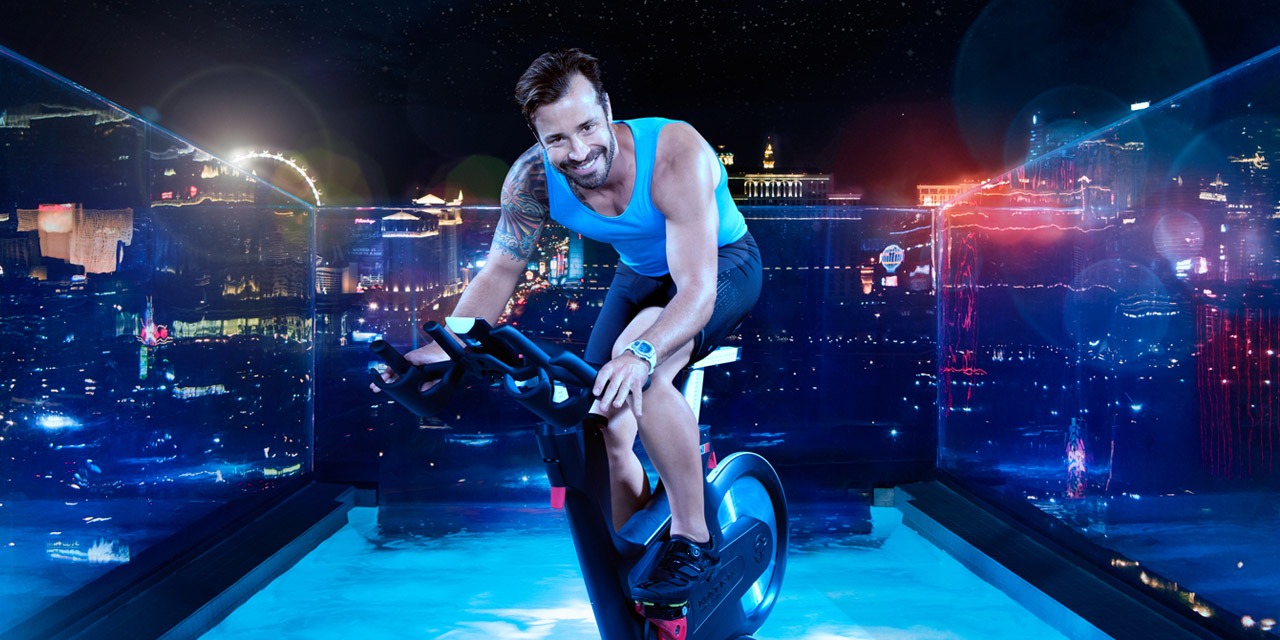
Another important development is the technology now present in most people’s living rooms. A growing number of people have large TV screens that are connected to their home internet, or that link up with services and consoles like Apple TV, Amazon Fire Stick and Chromecast. If you’re able to offer fun options for working out in this environment, then people will undoubtedly use them.
How are you embracing this new technology?
We’re using all of this technology, creating the perfect experience for any CYBEROBICS user whatever device they use to access our classes – all at a very attractive price point.
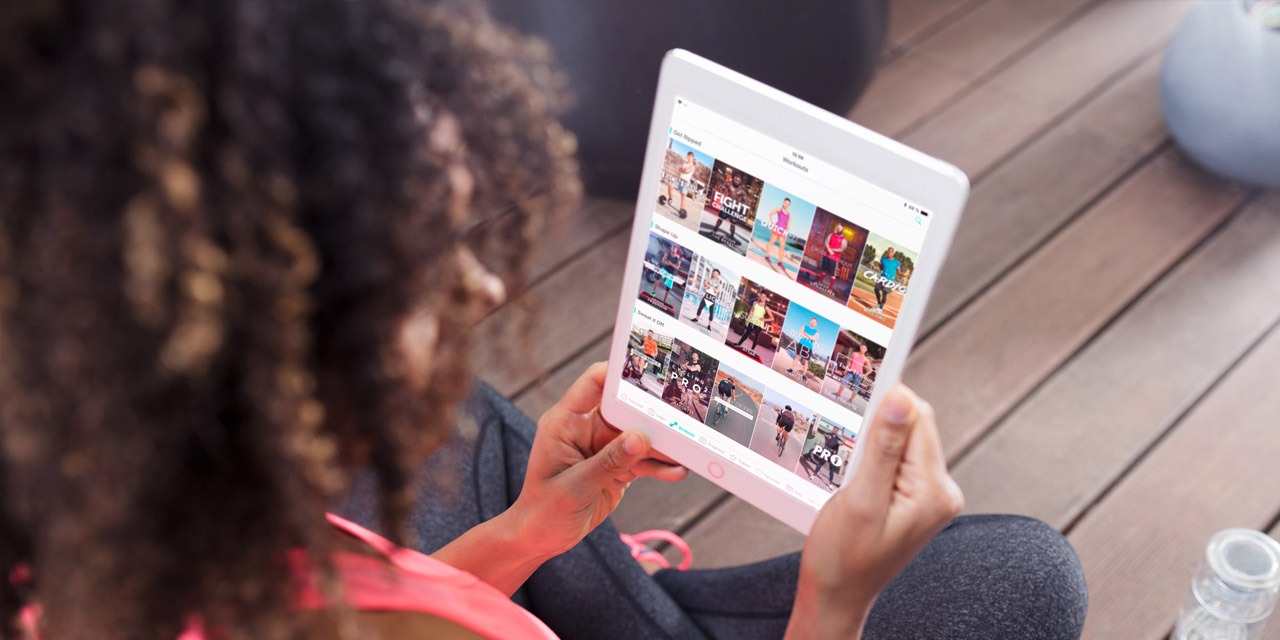
The CYBEROBICS app was launched in the spring of 2018 and is now available in 21 countries. Using the app, CYBEROBICS workouts can be played on all the devices people already have at home: all mobile phones and tablets (iOS and Android), internet, Apple TV, Chromecast, Amazon Fire and Roku.
The growth rates are huge and we will pursue this path systematically while introducing new features and tapping into new markets.
Many gyms have been slow to embrace virtual group exercise. Why do you think this is?
Many operators of gym facilities or fitness chains are still blissfully ignorant of the aforementioned developments in the digital sphere. This is because, thus far, the trend has not been hugely evident in day-to-day business, so gym owners have seen no reason to address it.
As this trend gathers pace – which it inevitably will – many more providers in the fitness industry will wake up and find they are forced to react quickly in order to survive. For some, unfortunately, it will already be too late. They will realise that other players – who will sometimes come from outside of the fitness industry altogether – have already taken over part of the business.
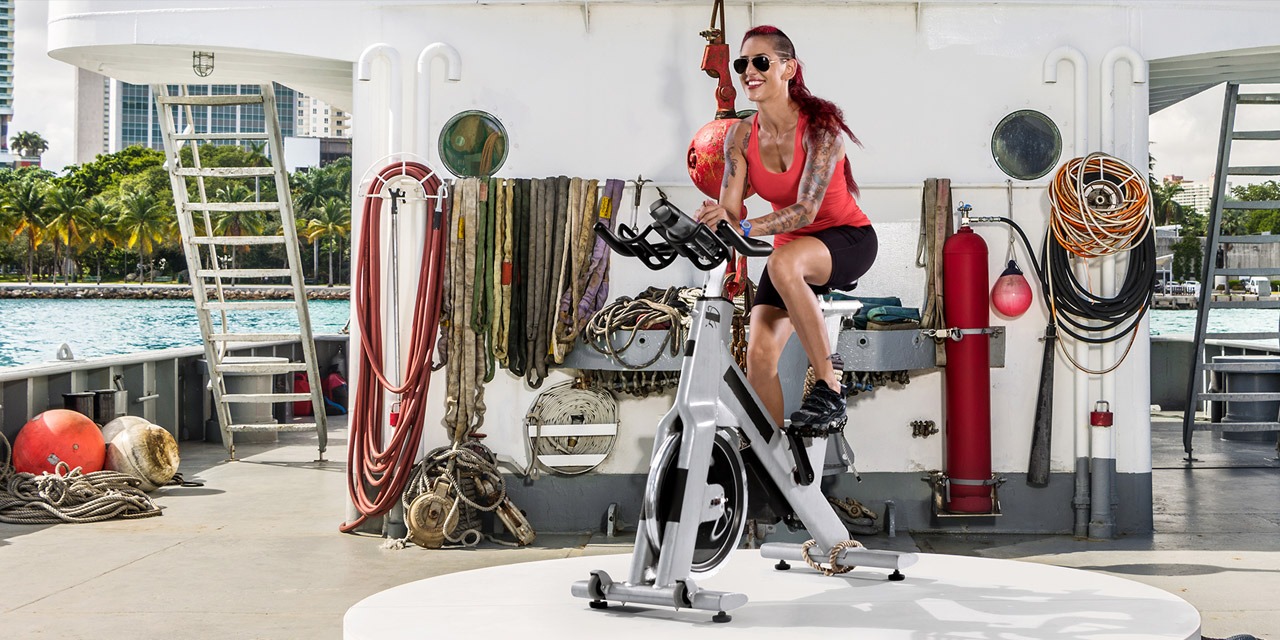 Club operators need to exploit digital developments: the aim has to be to offer a digital product directly within the club which members are also able to use outside of the club. In this way, the club’s offering can be expanded into other areas of members’ lives and an emotional connection established. This is the role we see for CYBEROBICS, which can be used in the studio, but also at home and while travelling.
Club operators need to exploit digital developments: the aim has to be to offer a digital product directly within the club which members are also able to use outside of the club. In this way, the club’s offering can be expanded into other areas of members’ lives and an emotional connection established. This is the role we see for CYBEROBICS, which can be used in the studio, but also at home and while travelling.
If a club fails at this, then members will use the digital offerings from other providers and there’s a risk the club will lose them over the long term.
Do you believe virtual classes will ever replace live, instructor-led classes?
I think we will continue to see a combination of both, but with a clear trend towards virtual training – including live streaming. Live classes will always have their place, but people like flexibility in the way they work out: one day they might want a convenient workout at home; another day, they’ll go to the gym.
What have been CYBEROBICS’ most important innovations in group cycling?
CYBEROBICS offers a wide array of cycling experiences for all fitness levels – all led by the best trainers from the US and all in extraordinary locations. One cycling class was filmed by the pool at Hugh Heffner’s house, for example, with a view of downtown Las Vegas. For another cycling class, we rented a magnificent yacht that sails through Miami Bay for the 60 minutes of the workout. That’s what makes CYBEROBICS cycling classes unique.
Cycling through beautiful landscapes in training groups and virtual cycling in artificial environments are also part of our portfolio. In addition, we integrate key fitness trends into our cycling classes – HIIT training, for example. We’re always trying to offer our users something new by picking up on current trends and incorporating them.
What do you feel CYBEROBICS brings to cycling studios?
A sense of immersion. Thanks to the high-quality production of our classes, our users actually feel as though they’re training in the place where the workout is shot. This demonstrably boosts motivation and enjoyment of training – and in turn, the workout becomes more effective.
Ideally, the spaces in which people are cycling should offer a cinema-like atmosphere with a large screen, dark walls, really good sound and lighting that’s not too bright. Only then can the sense of immersion be experienced to full effect.
My advice to operators is very simple: by all means, combine them with live classes initially, or even in the long term, but integrate virtual classes as quickly as possible – not just cycling but across the board. And spare no expense in fitting out the studio with all the necessary technology, creating an entirely new training experience for members.
How are you using CYBEROBICS within your own clubs?
We have two CYBEROBICS studios per club in more than 230 RSG Group clubs – McFIT, JOHN REED and High5. One is for indoor cycling, the other for all other CYBEROBICS classes.
We currently deliver more than 5 million CYBEROBICS classes a year, with new workouts frequently added, and they have been well-received. We also offer members access to our CYBEROBICS app, so they can take part in classes at home or while travelling too.
Digital will be a key focus at THE MIRAI too [RSG Group’s 20,000 sqm, free-to-use megaclub that’s scheduled to open in Germany in 2022], so CYBEROBICS will play an important role here. We will use THE MIRAI as a ‘future lab’ for continual development of CYBEROBICS.
You also work with hotels and corporates. What’s the latest news here?
In both areas, we’re seeing a strong momentum towards digital fitness solutions.
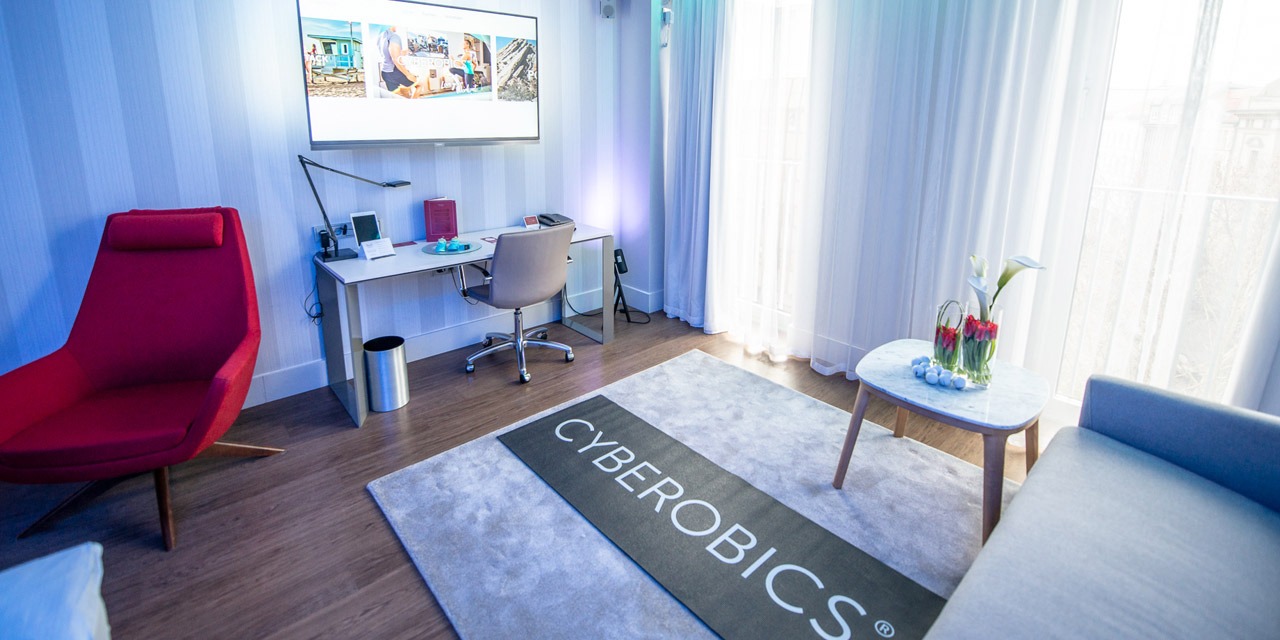 In the hotel industry, lots of providers are already using CYBEROBICS. The NH Hotel Group, for example, has started creating ‘mood rooms’ in which you can set different moods using a tablet; choose ‘active mood’ and the light and sound changes automatically, the curtains close and a CYBEROBICS class begins on the TV. The TUI Group has likewise started using CYBEROBICS in its hotels.
In the hotel industry, lots of providers are already using CYBEROBICS. The NH Hotel Group, for example, has started creating ‘mood rooms’ in which you can set different moods using a tablet; choose ‘active mood’ and the light and sound changes automatically, the curtains close and a CYBEROBICS class begins on the TV. The TUI Group has likewise started using CYBEROBICS in its hotels.
Cruise company Aida is gradually introducing CYBEROBICS on all its ships, both in the cabins and in its workout studios, as well as on large screens on the pool deck so people can take part in cycling classes against the glow of the evening sunlight, for example.
The RSG Group, which owns CYBEROBICS, is also working with more than 600 companies in the area of corporate fitness. Here, too, the trend is towards in-house gyms that incorporate CYBEROBICS studios, combined with access to the CYBEROBICS app to train at home and during breaks at work.
What do you believe is the secret of CYBEROBICS’ success?
Without doubt, it’s the conceptual approach and the quality of the content. Our basic idea is not merely to replace the live trainer by filming them and then projecting them onto the wall in the studio, but rather to create a unique training experience. To achieve this, we have spared no expense or effort in production.
In the future, we plan to enhance the workout experience using virtual reality.
The workout concepts are created by our sports scientists, while scouts in the United States look for the right locations and hold extensive trainer casting sessions. Once the locations and trainers have been selected, the instructors are briefed on how to carry out the workout and we do rehearsals; only once they have mastered the workout perfectly is it filmed.
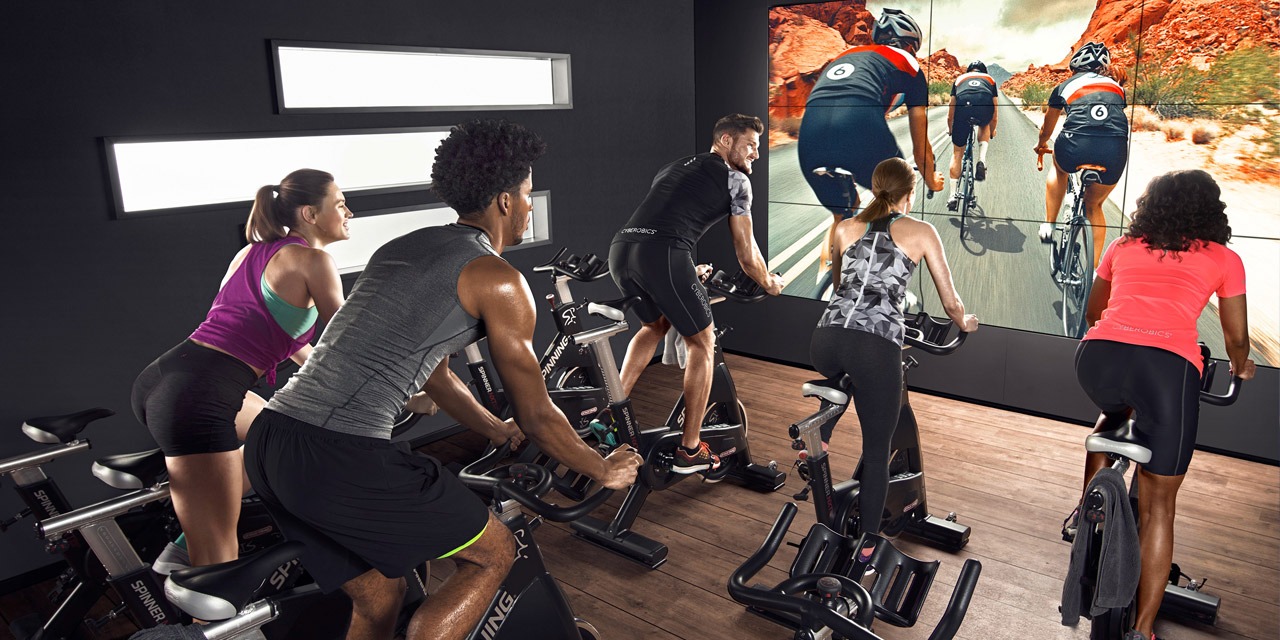 For this, we use a team and equipment worthy of a Hollywood production, filming in 4K quality and with multiple cameras to capture the action from all angles. After post-production in Berlin, our music managers compose a perfectly tailored soundtrack specific to each workout and we record voiceovers, currently in five different languages: English, German, Spanish, Italian and Polish.
For this, we use a team and equipment worthy of a Hollywood production, filming in 4K quality and with multiple cameras to capture the action from all angles. After post-production in Berlin, our music managers compose a perfectly tailored soundtrack specific to each workout and we record voiceovers, currently in five different languages: English, German, Spanish, Italian and Polish.
In the future, we plan to enhance the workout experience – beyond the quality of the content – with the use of new technologies such as AR and VR.
What will be the next big trend in fitness, and is CYBEROBICS already working on this?
Live streaming of classes is already available but is not yet a mass product. That’s something that will undoubtedly grow. Virtual participation in classes at home is also set to grow, so people don’t have to miss out on the group experience entirely. Here, too, the possibilities of digitisation are endless. We are working intensively on both of these areas at CYBEROBICS.
Also, as I just mentioned, we’re going to try using augmented and virtual reality, which is already proving hugely popular in the gaming industry. There’s currently still a lot of potential for optimisation, but I’m convinced that further development of this technology will offer opportunities for the creation of exciting new CYBEROBICS experiences in the future.
What’s your view on the threat of technology like Peloton?
Peloton’s approach is a good one, and it shows that the home market offers huge potential. I think we’re all just at the beginning here; future developments are going to be huge. At CYBEROBICS, we’re reviewing whether – and in what form – we’re able to harness these possibilities.
What’s the future of indoor cycling?
When we, as CYBEROBICS, look at the cycling market, we see that successful concepts always offer a special experience, be it SoulCycle in the boutique club segment or Peloton, with its similar approach but for the home market. Meanwhile, clubs and studios around the world are striving to create engaging cycling spaces, with great design and AV systems.
In the future, we believe virtual reality offers huge potential for cycling. In many areas of fitness, the use of VR goggles presents a problem due to the risk of injury – when participants are moving freely, they quickly lose orientation when wearing the goggles. With cycling, however, the user is ‘stationary’ and can, therefore, use VR goggles much more safely. It won’t be long before technology allows us to introduce VR, including group experiences, into cycling classes.

